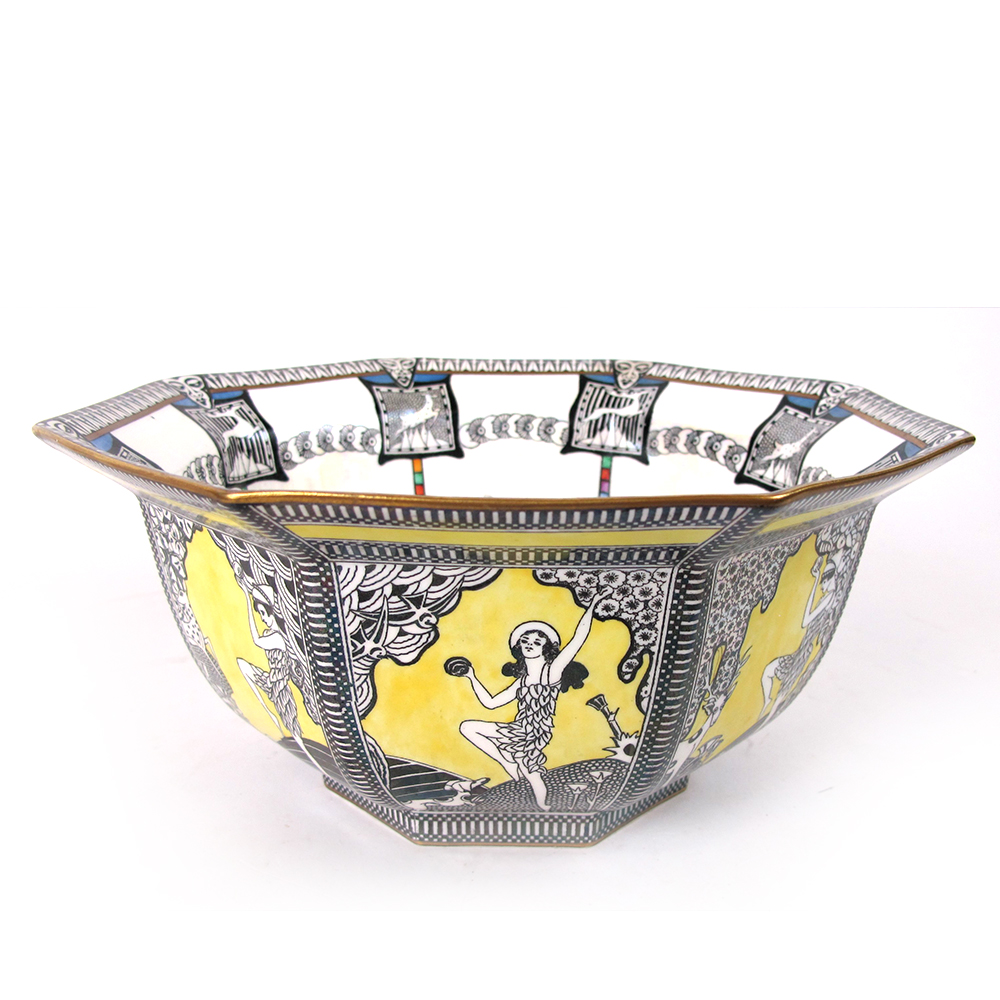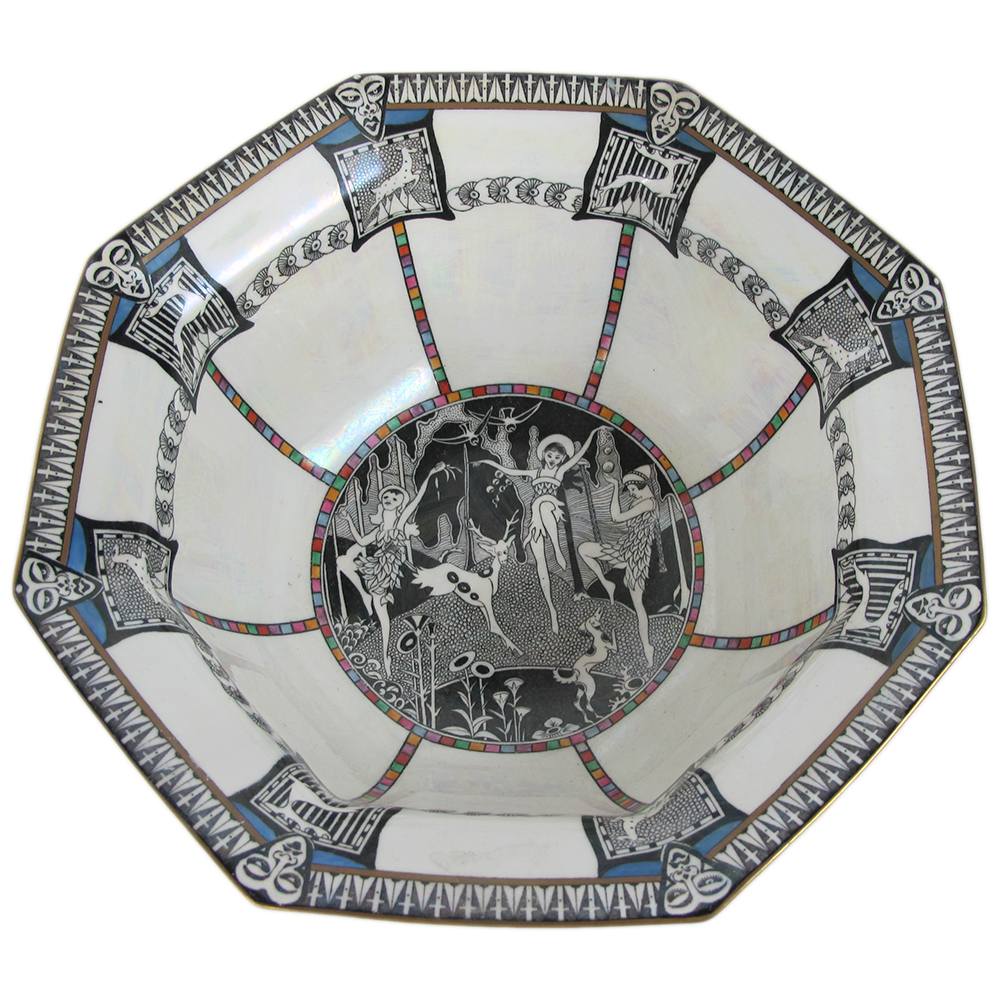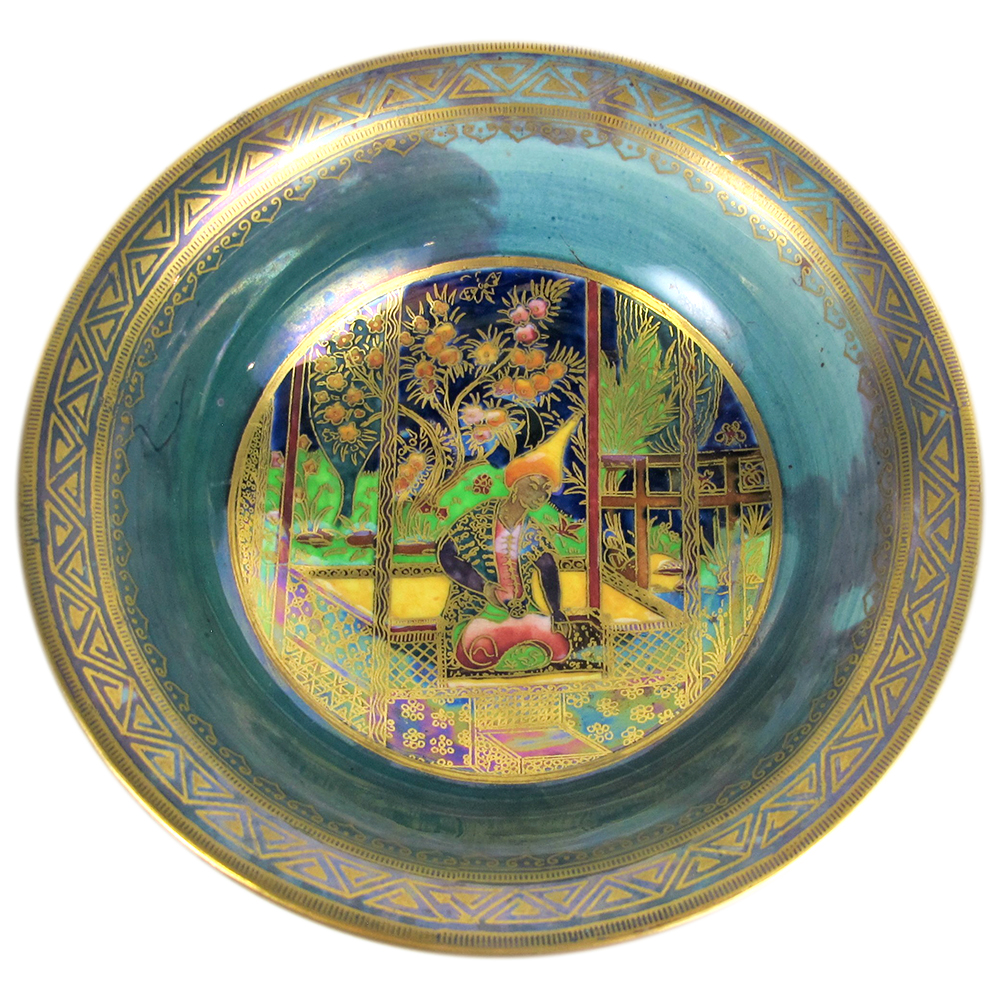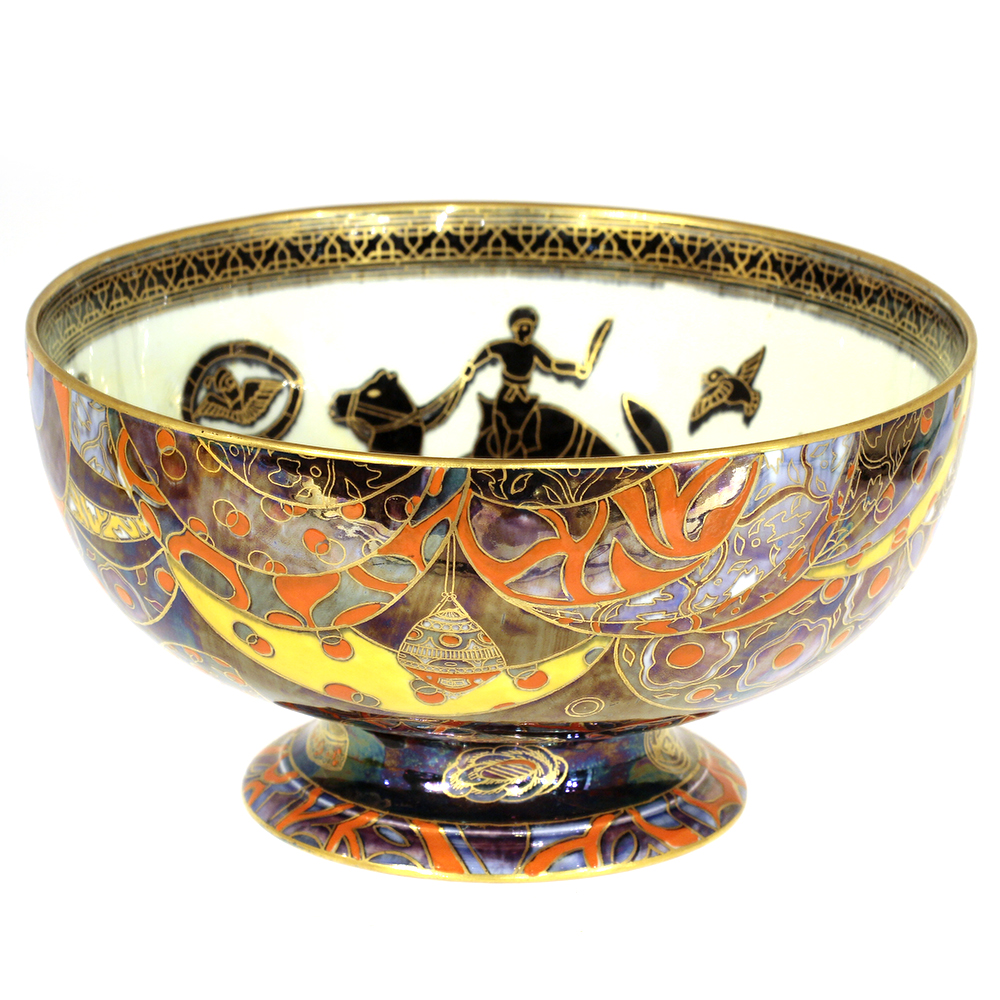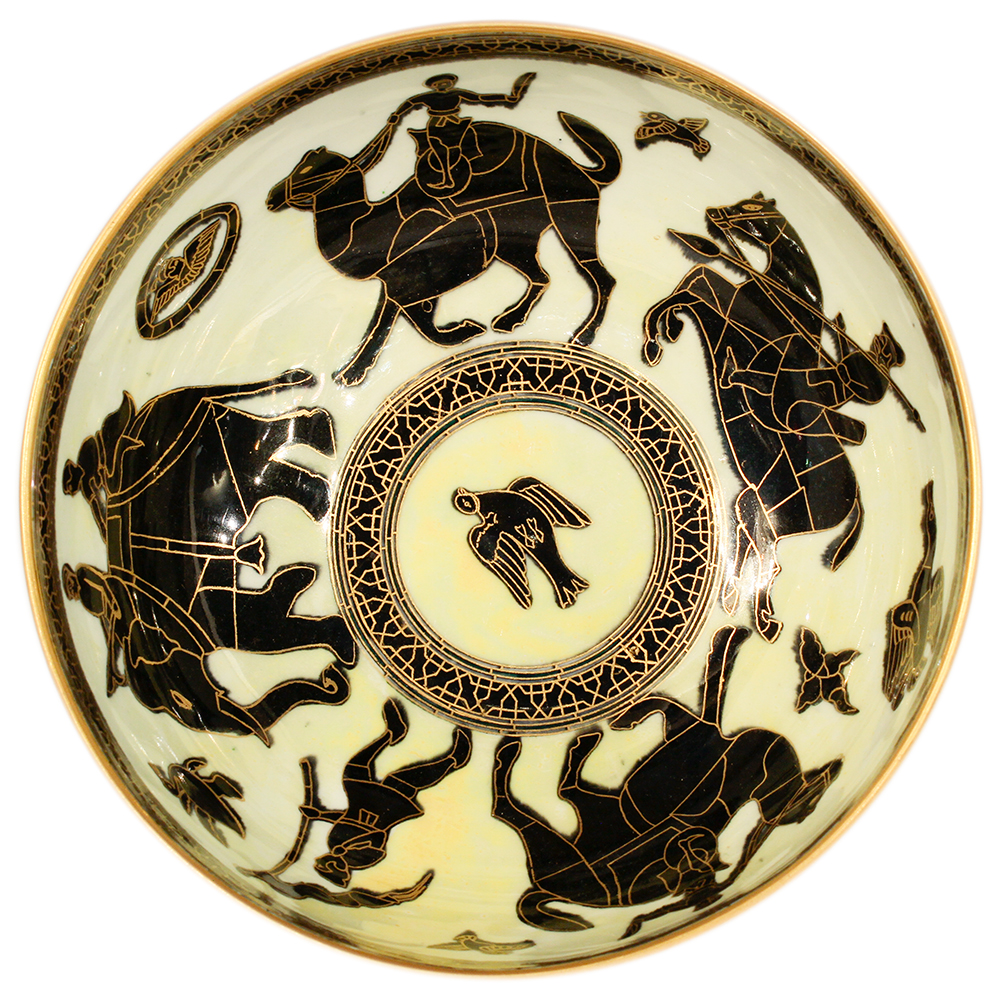Most of our visitors are bowled over by Wedgwood’s Fairyland Lustre ware when they visit WMODA so for the next couple of months, we are exhibiting our extensive Fairyland bowl collection as part of our Fall Fantasy. This is a wonderful opportunity to study the fantasy art of Daisy Makeig-Jones in detail.
Daisy’s first Fairyland Lustre design in 1915 was Poplar Trees for the exterior of an Imperial shape bowl. The landscape depicts an Italianate park with trees, statues a fountain and a bridge. The scene was inspired by the fairytale illustrations of Kai Nielsen for In Powder & Crinoline which was published in 1913. Daisy was much influenced by this Danish artist’s work and elements of his designs can be seen in other bowl patterns such as Moorish and Geisha. The original Poplars Trees were painted green against a black sky with golden foliage, but the pattern was also produced in Flame Fairyland, where the sky is orange over shaded crimson.
The best way to discover all the marvelous detail in Wedgwood Fairyland Lustre is to pour over the remarkable reference book by Una des Fontaines. She published a comprehensive guide to the subject in 1975 which was accompanied by her intricate drawings of Daisy’s designs. These are invaluable in identifying the various Fairyland patterns on the bowls as the detail is often difficult to discern under the lavish luster glazes. Daisy’s interpretation of her Fairyland Lustre designs can be seen in the delightful booklet published by Wedgwood in 1921.
A variety of Fairyland patterns can be found in the interior of the Imperial bowls. One of the most extensive series is known as Woodland Elves and is found in eight variations. The designs are characterized by slender tree trunks with exotic foliage populated by elves, fairies and other little people flying around or scrambling in the roots. Identifying features for the different designs include a spider with its web, a fairy in a feather hat, a toadstool, a fiddler perched in a tree and a boxing match. The last three designs appear on Octagon bowls with companion exterior scenes designed specifically for the eight panels. The most popular exterior design was called Dana after the Celtic Earth Mother Goddess, who Daisy claimed was the “mother and queen of all the fairy folk”.
Small bowls and cups, including a spectacular Persian cup inspired by an ancient glass vessel, feature a frieze of leap-frogging elves disporting around the exterior, sometimes against a starry night sky. The interior often depicts two baby elves, which have a strong resemblance to the Kewpie dolls. An elegant Chalice bowl and a large Melba cup show off the various Fairyland patterns to great advantage, as does the shallow Lily tray. The interiors of the larger bowls often had different center patterns, including a mermaid in swirling waves.
Daisy’s stories behind her Fairyland designs are often quite sinister. In the Elves and Bell Branch design, fairies, elves, kobolds, and will-o-the-wisps have been taken prisoner by a spider and put into a dark cave from which they cannot escape as the spider has spun her web all over the entrance. According to Daisy, all spiders become Oni or demons after dark and are very difficult to kill. They have no blood but are filled instead with a white sticky substance which is magic. Fortunately, a golden bird has come to rescue the fairies and has given them a bell branch to save them. Whenever this branch is waved, whoever hears it is put to sleep and the fairies are debating how to put the spider under its influence without being overcome with sleep themselves.
In another design known as the Garden of Paradise, Daisy has paraphrased the fairytale of the same name by Hans Christian Anderson. Over beyond the Himalayas lies a beautiful garden entered by a cave whose walls are covered with jewels of entrancing beauty. In it is the Tree of Knowledge, which is covered with cakes instead of fruit, and on the cakes is written all the history, geography and learning of the world. Whoever eats one never forgets what was written on it. The most beautiful thing in the garden is the Fairy who owns it. If a man kisses her before a year and a day has elapsed, he finds himself outside. No one has ever spent more than a few hours in the garden and so learning is obtained with difficulty.
As can be seen, there are few fairies in diaphanous dresses with butterfly wings in Daisy’s designs. In general, she prefers to depict the darker denizens of fairyland. Perhaps the strangest are the Firbolgs, a comical collection of agitated little beings with eyes like saucers. According to Daisy, the firbolgs or men of the bags were oppressed by their masters in the Land of the Dead who made them carry earth from the fertile valleys up to the rocky hills in leather bags. One day they revolted and filling their bags with air they floated to the surface and set sail for Ireland. When the Danaans came to Ireland there was a great battle and the Firbolg king was slain. Ulster was given to the Firbolgs and the Danaans took the rest of Ireland until they were defeated by Milesians and banished underground where they still live today. Despite being the longest line of any Fairyland pattern with several color treatments and more than 50 variations of shape and size, the Firbolgs were not very popular with the public and the pattern was withdrawn after two or three years. Only two Punch bowl styles remained in production by 1923.
As well as bowls decorated inside and out with Daisy’s Fairyland designs, she also produced patterns known as ‘Ordinary Lustres’ which are printed with dragons, humming-birds, butterflies and other decorative creatures outlined in gold. The backgrounds are mottled mother of pearl, powder blue, green, orange or ruby luster. Daisy devised more than a dozen dragon designs ranging from a Celestial dragon to encircle the exterior of bowls to a Cruel dragon for the interior. One of the most striking glaze effects which was used for both Fairyland and Ordinary designs was the Coral and Bronze with raised matt vermillion highlights. Occasionally, the famous Willow Chinoiserie pattern was given this dramatic treatment. Daisy’s fascination for fairyland led her to study the mythology of many different cultures and she adopted their imagery for several bowl designs, including Lahore from India, Nizami from Persia and Endymion from Greece, which features some incongruous flapper fairies.
See more Fairyland Lustre designs in our Innovations Gallery and our Fantastique exhibit, where you can also view our video about Daisy’s dark side.
Hear curator Louise Irvine talk about the Fabulous Fairyland Lustre collection at WMODA – 11:30am on Sunday September 22
Read More...
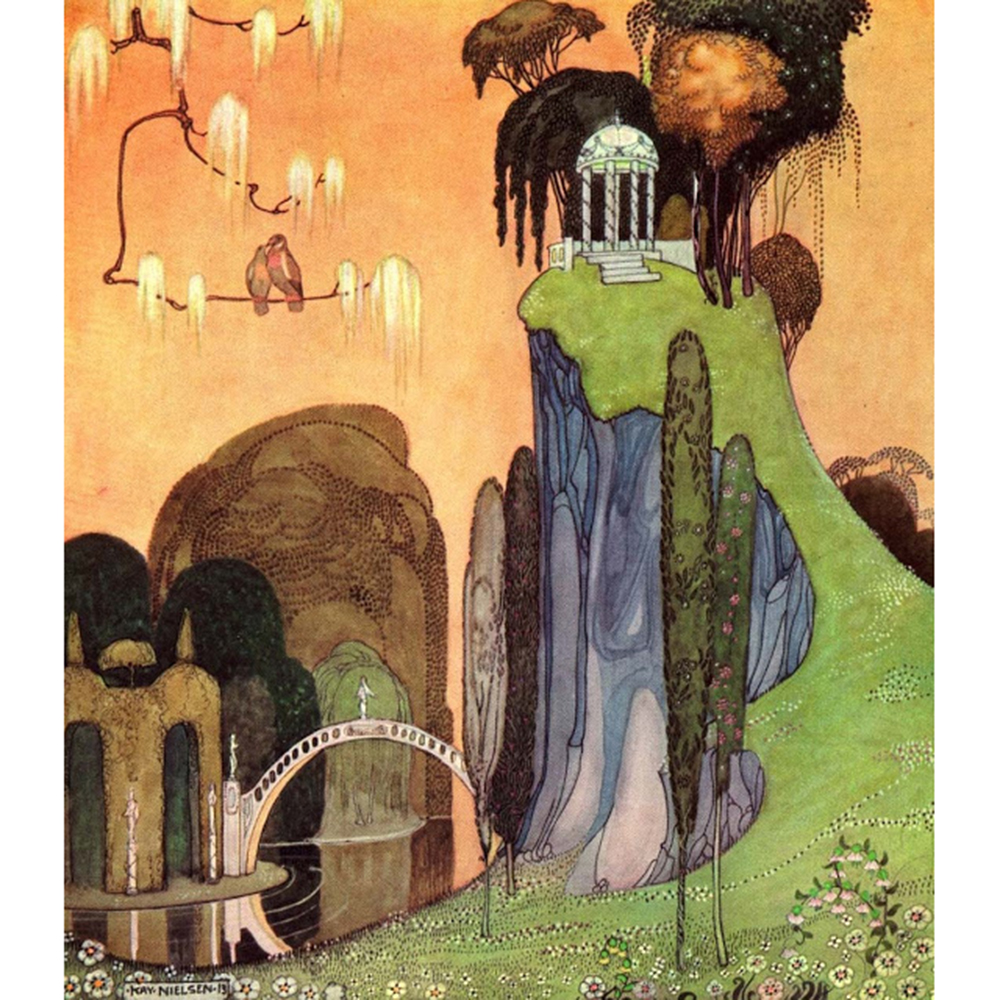
In Powder and Crinoline by Kay Nielsen
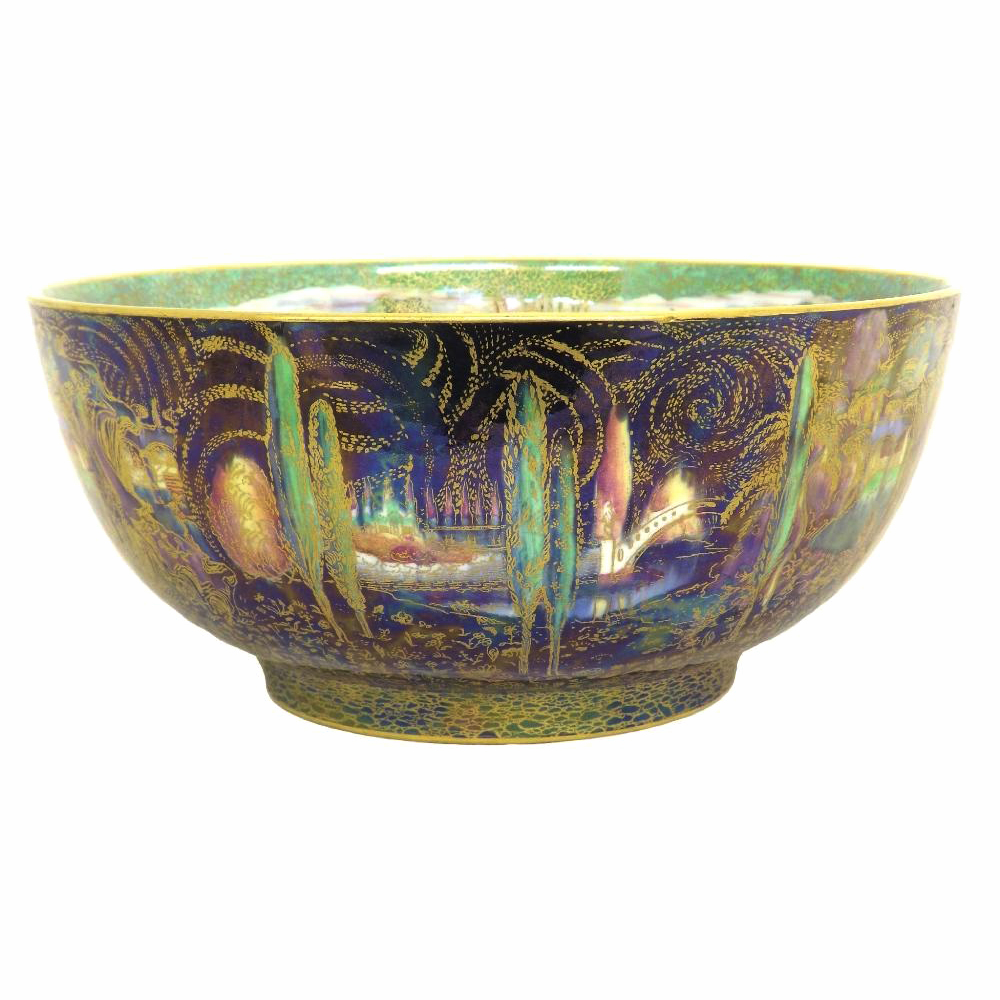
Poplar Trees Fairyland Lustre Imperial Bowl
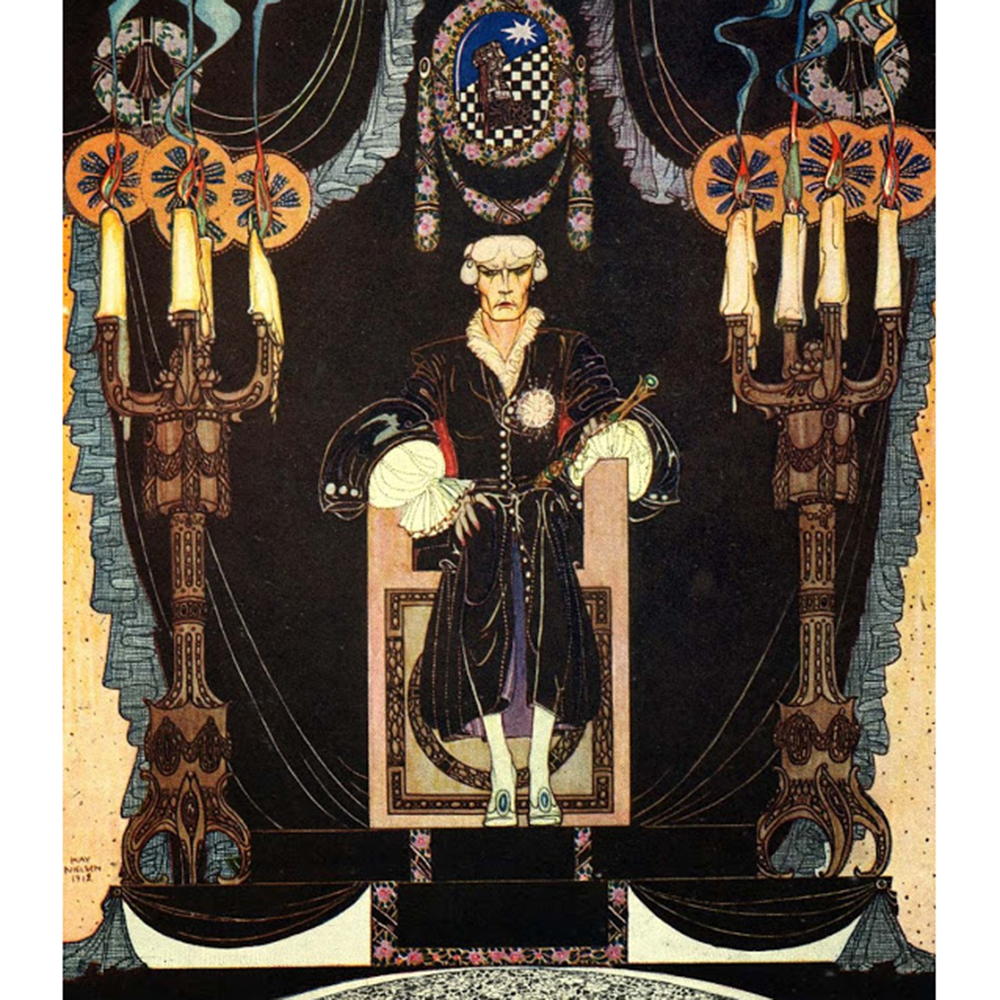
In Powder and Crinoline by Kay Nielsen
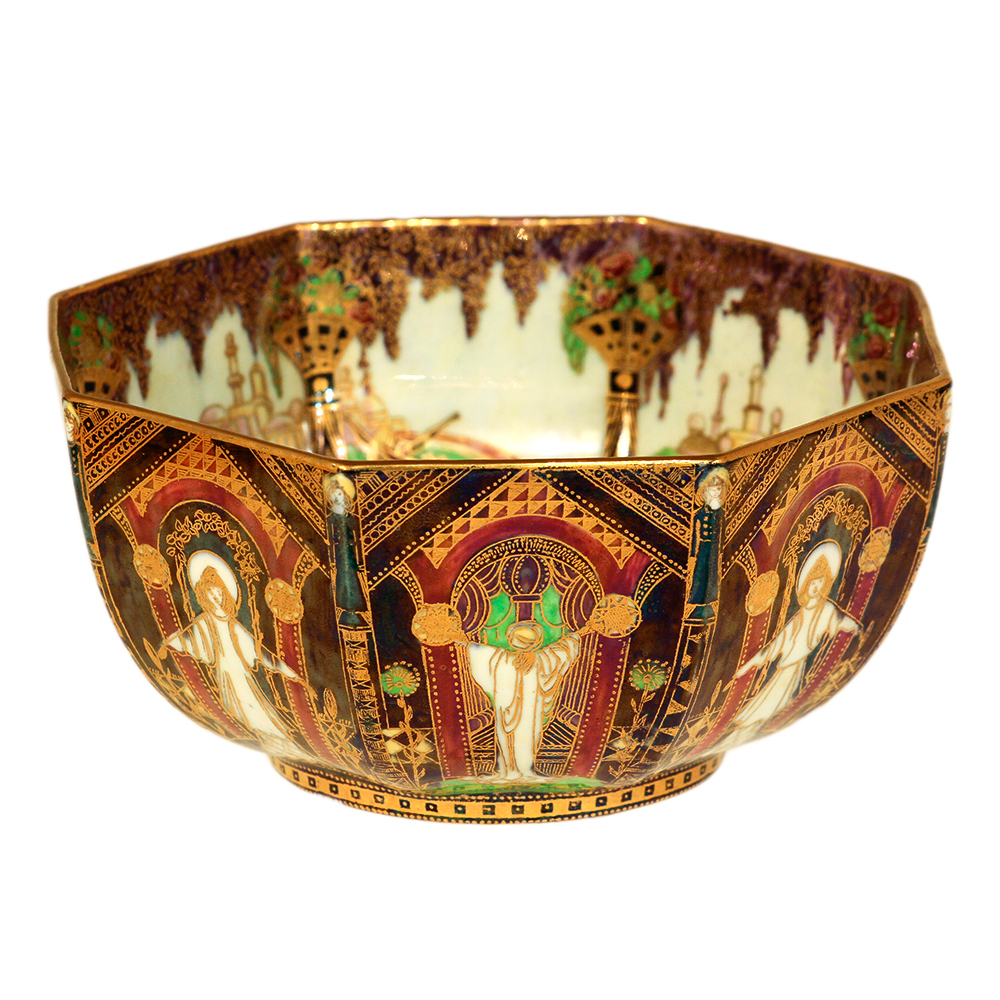
Geisha Octagon Bowl
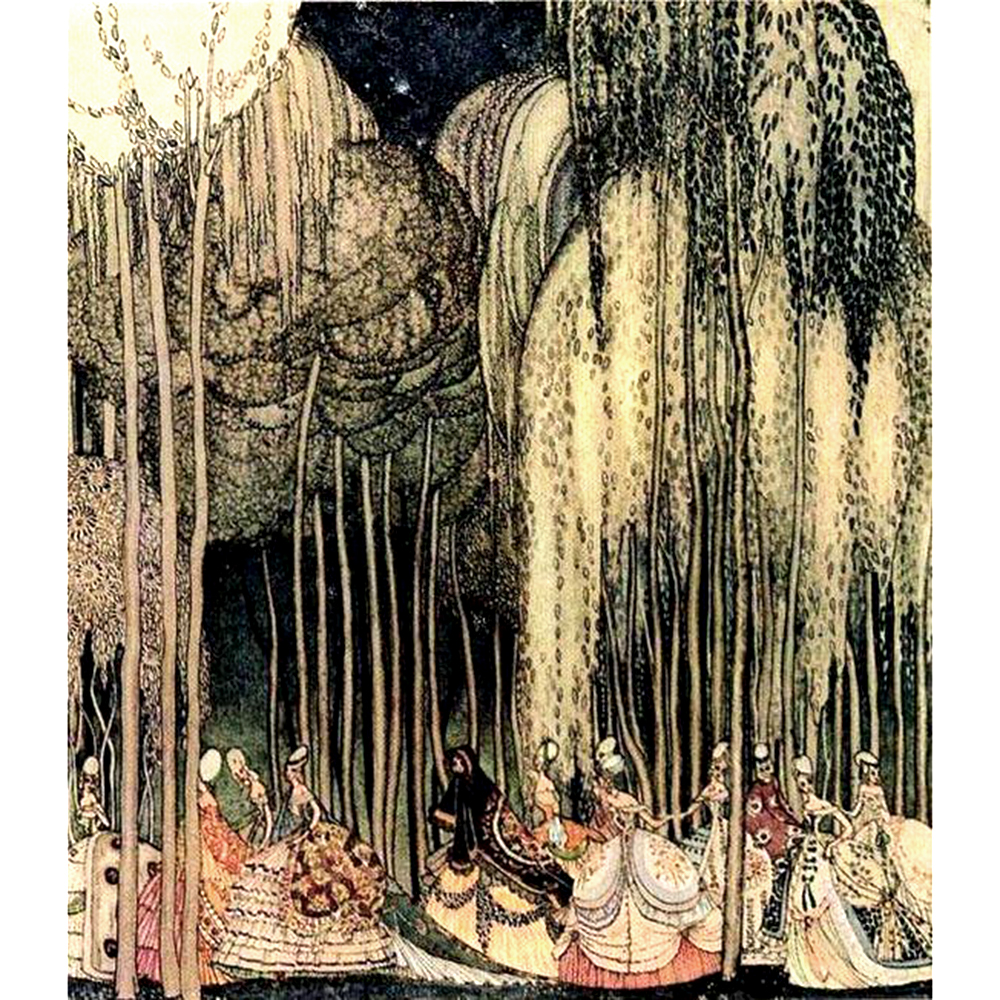
In Powder and Crinoline by Kay Nielsen
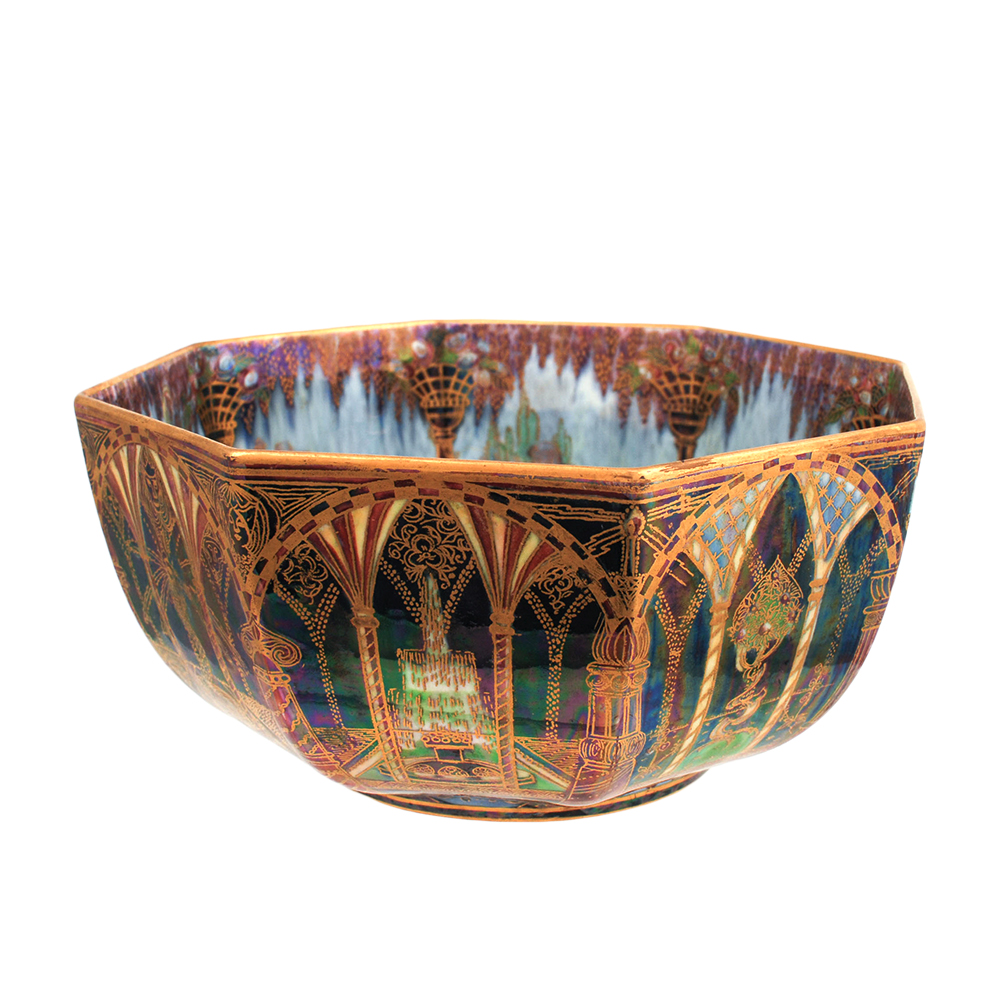
Moorish Octagon Bowl
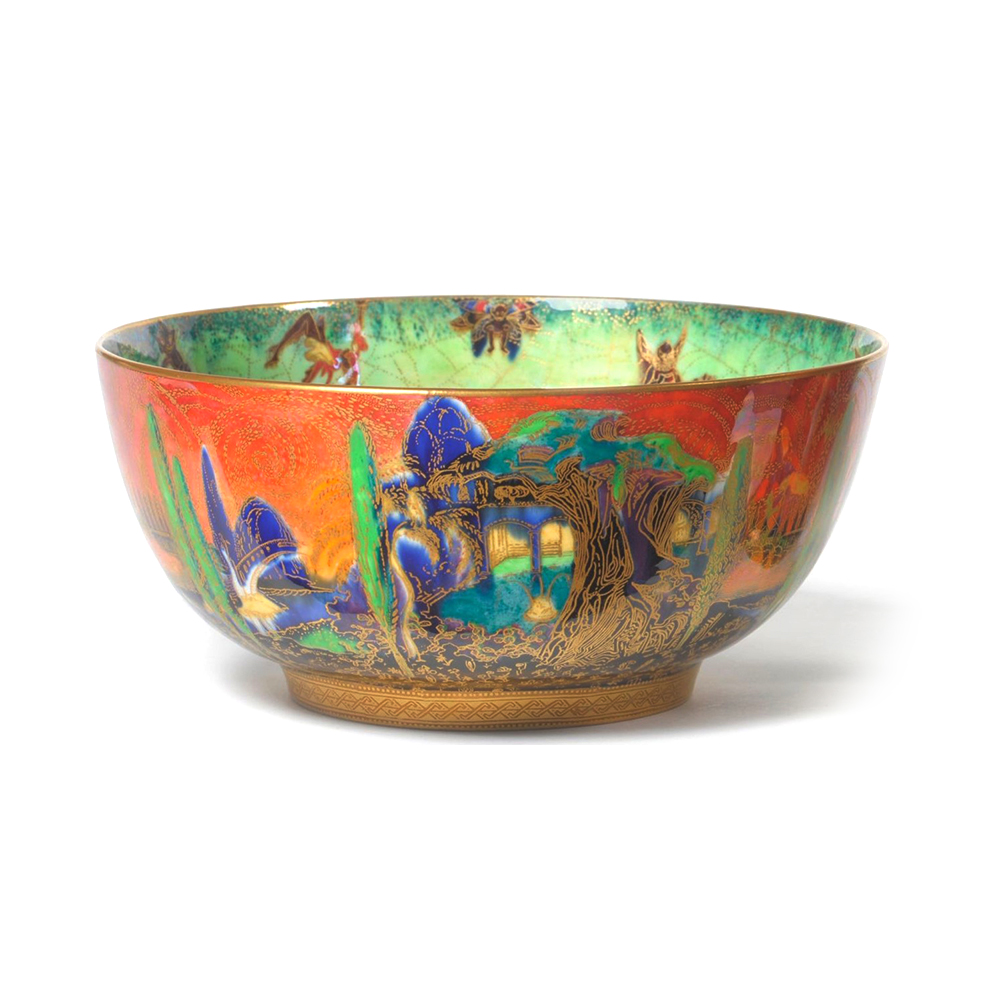
Poplar Trees Flame Fairyland Lustre
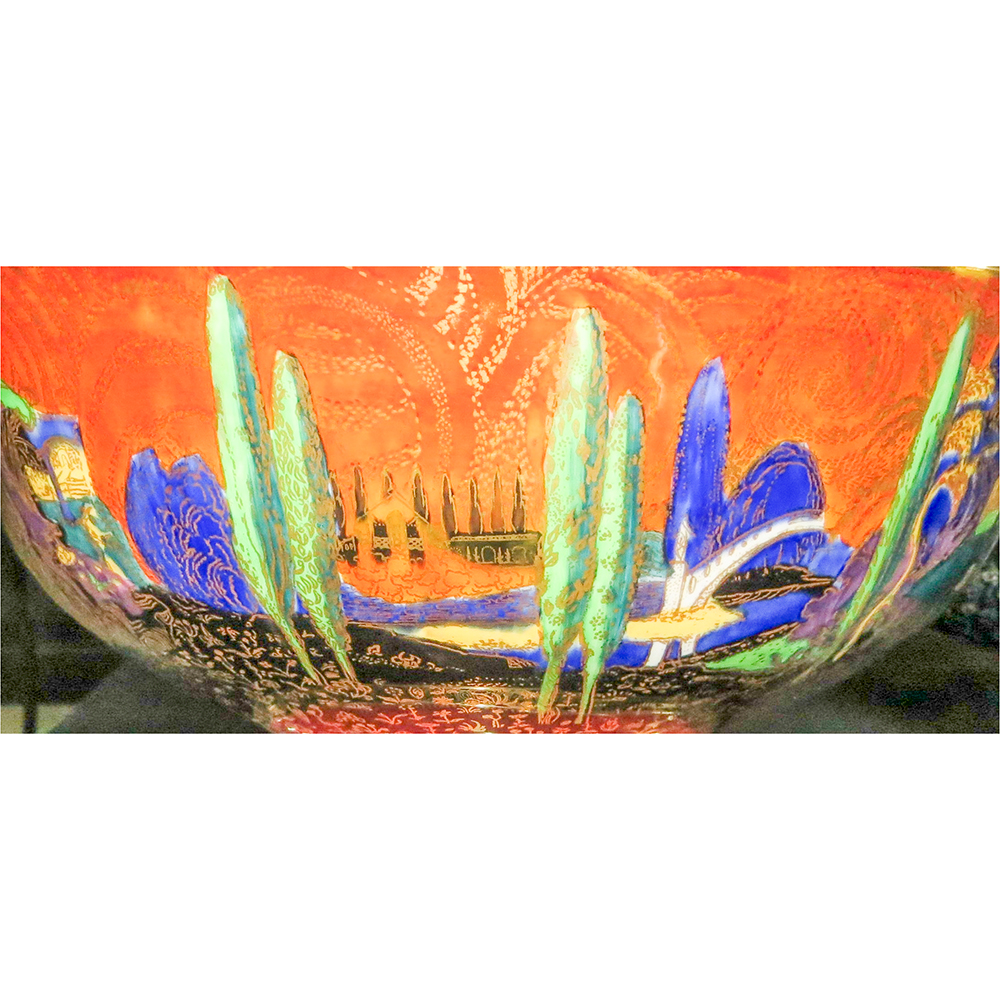
Poplar Trees Flame Detail
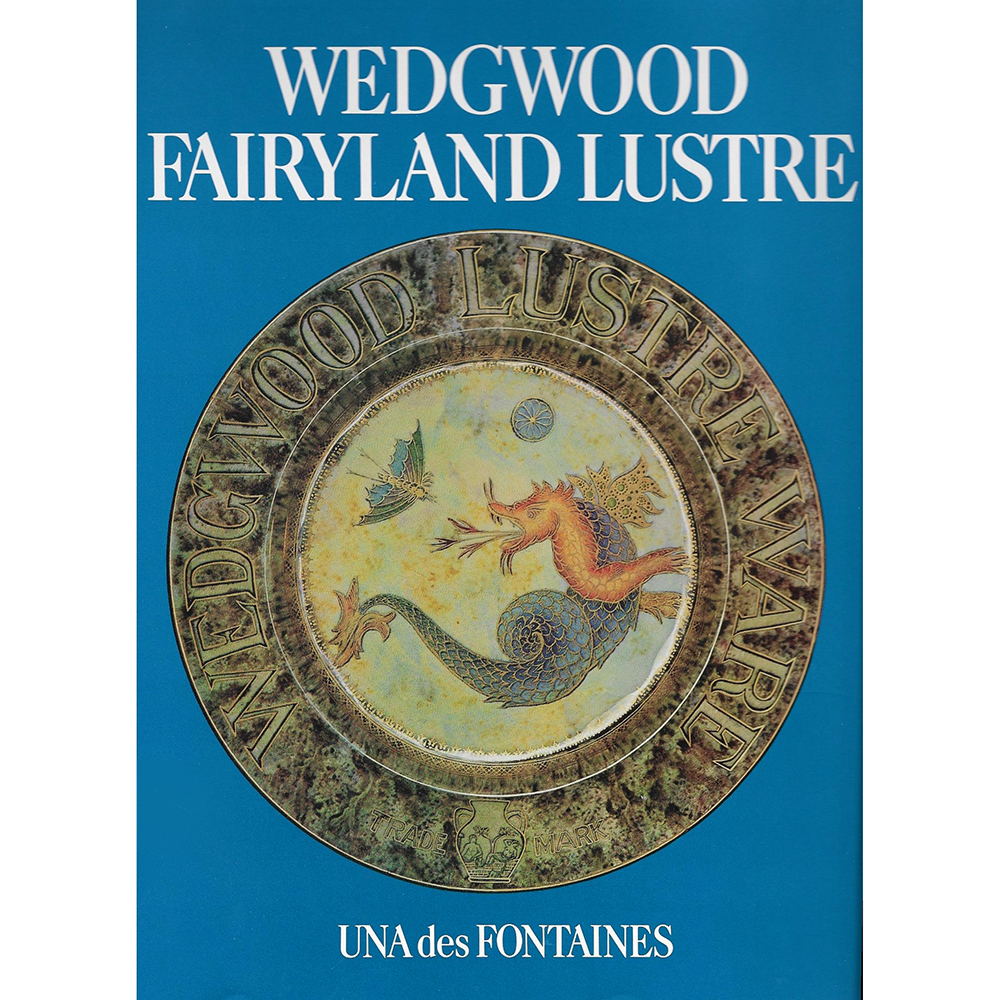
Una des Fontaines Wedgwood Fairyland Lustre
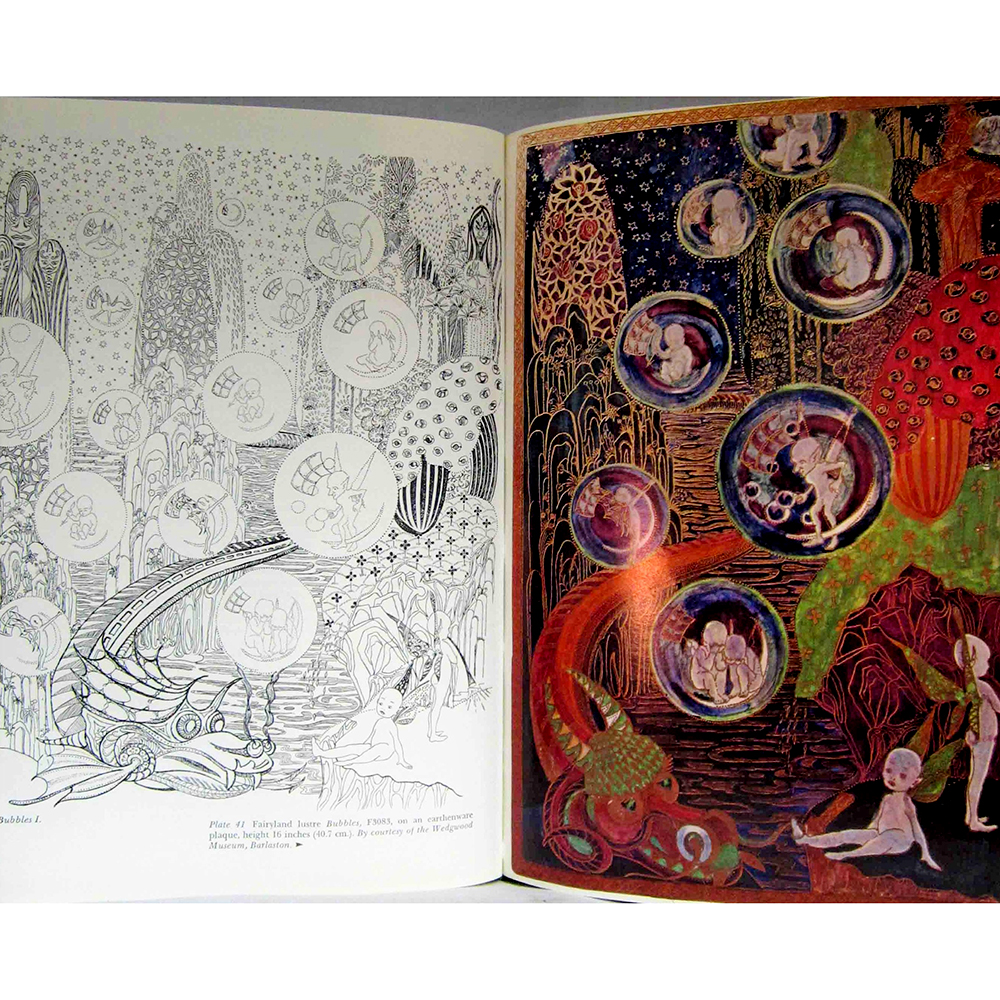
Wedgwood Fairyland Lustre Book
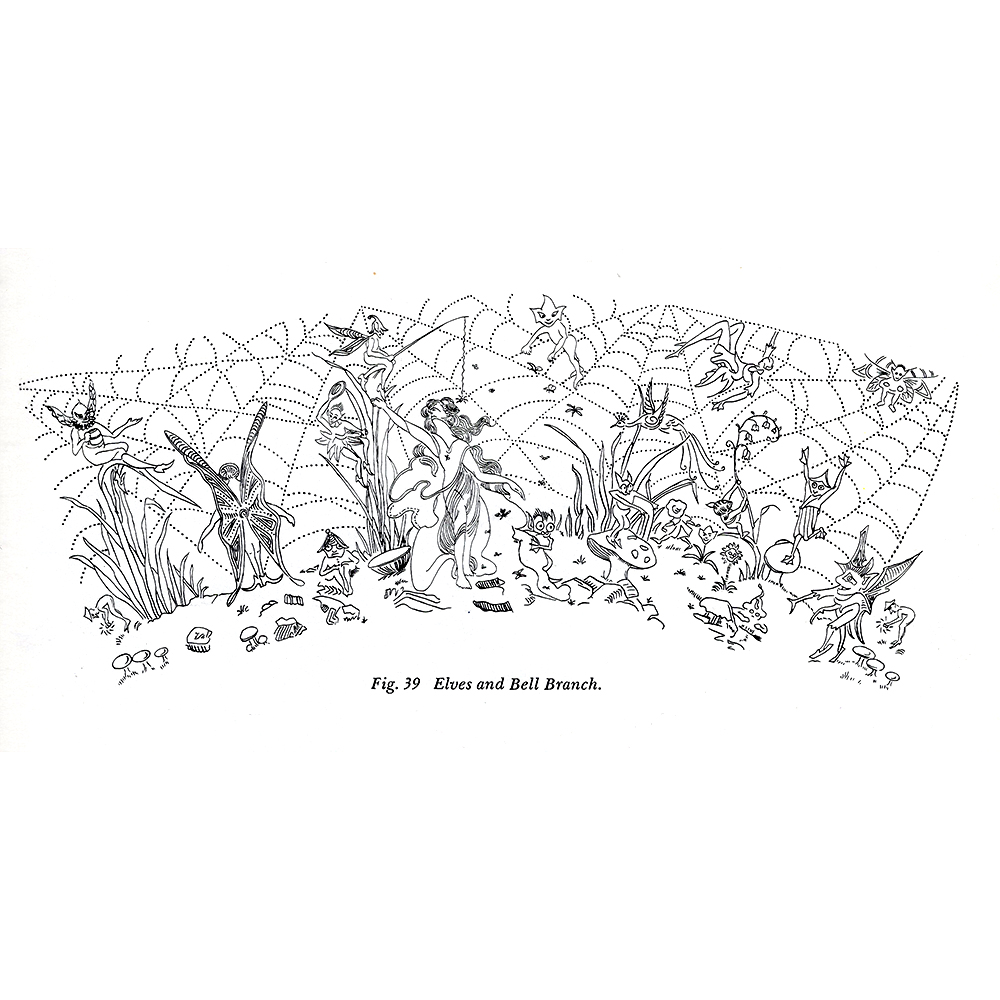
Elves & Bell Branch Illustration
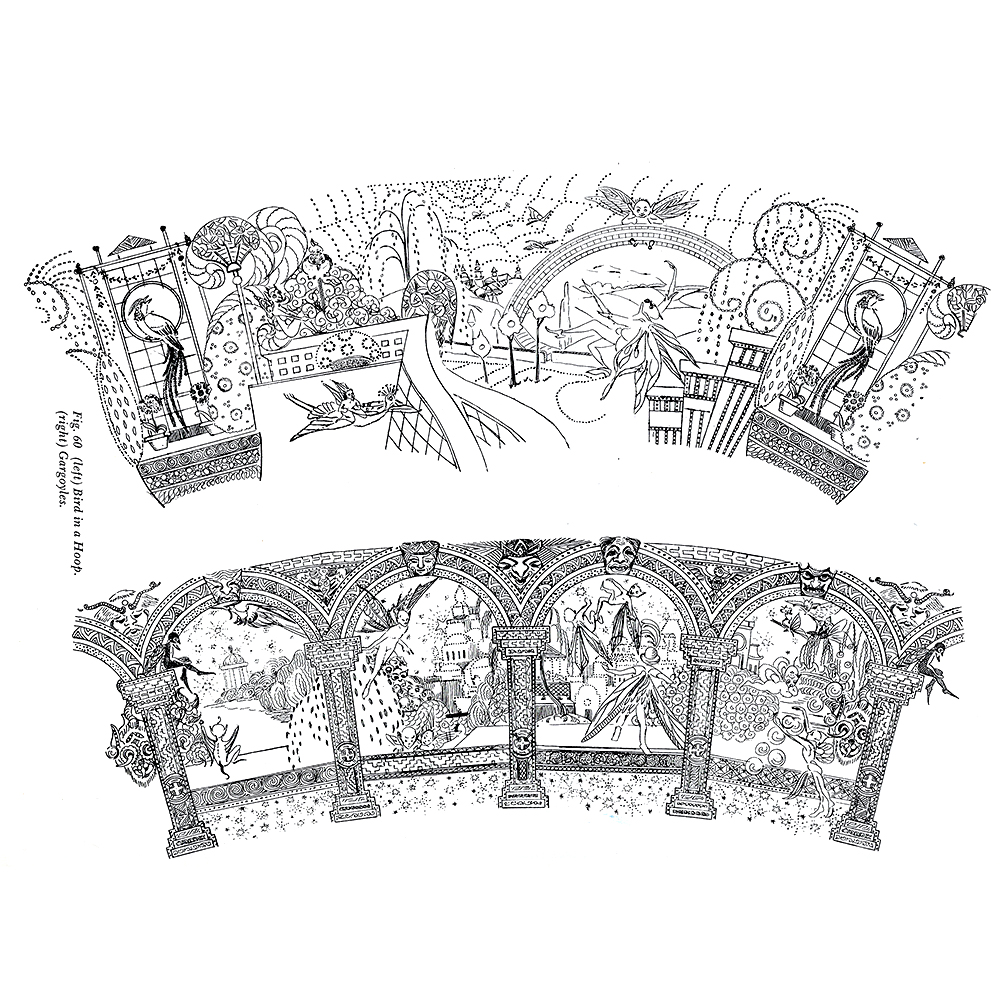
Bird in Hoop & Gargoyles Illustration
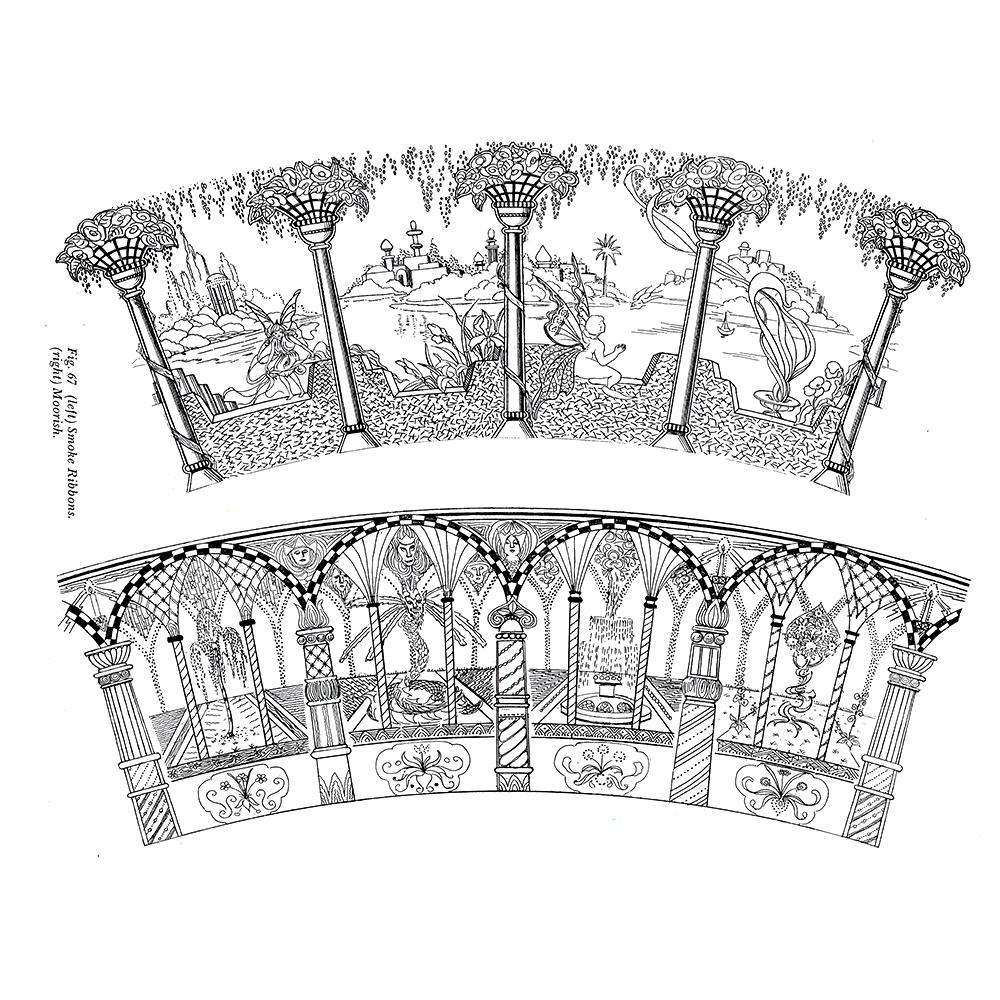
Moorish & Smoke Ribbons Illustration
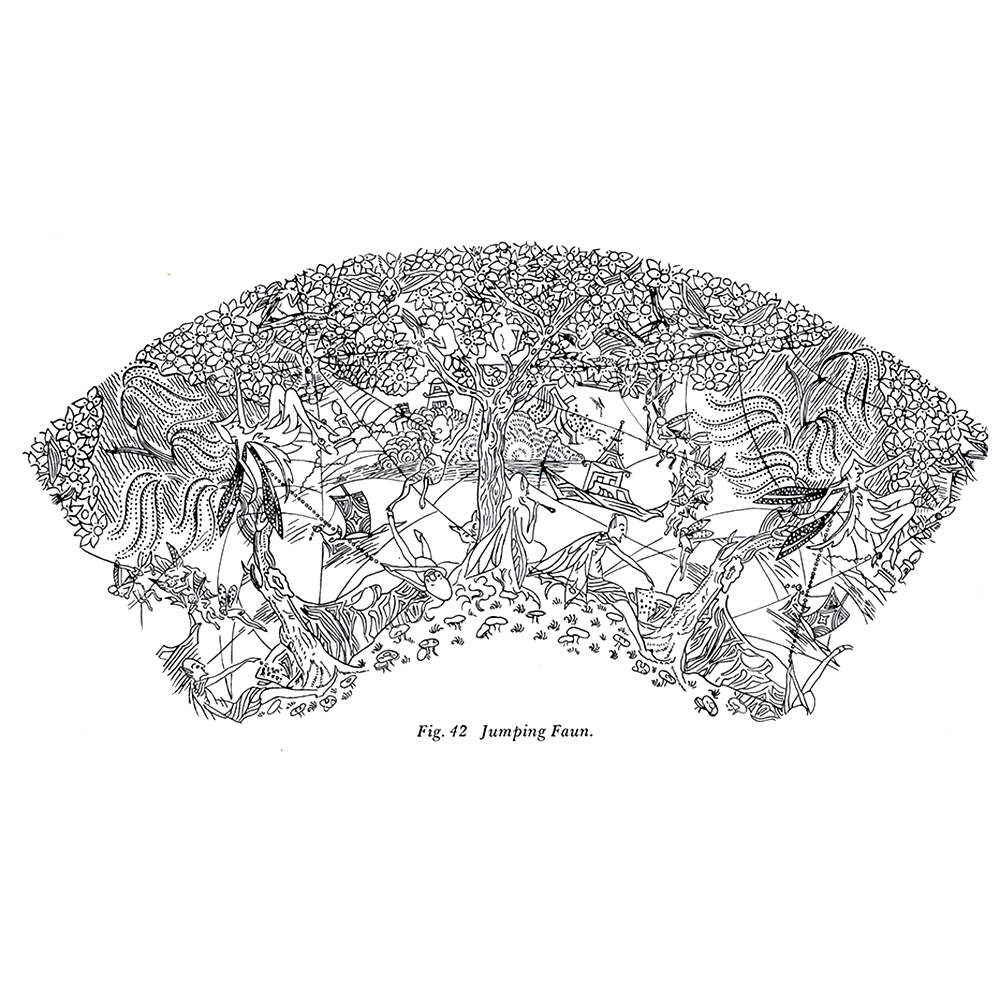
Jumping Faun Illustration
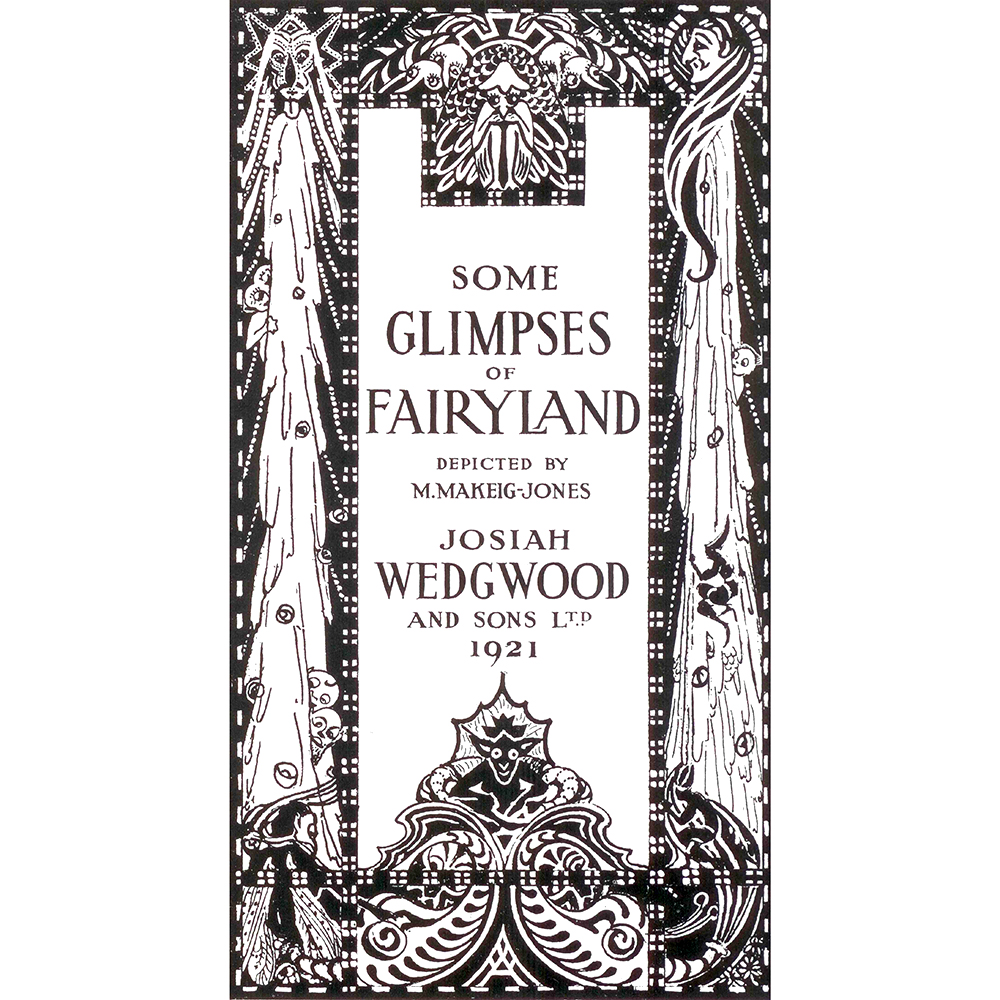
Fairyland Catalogue
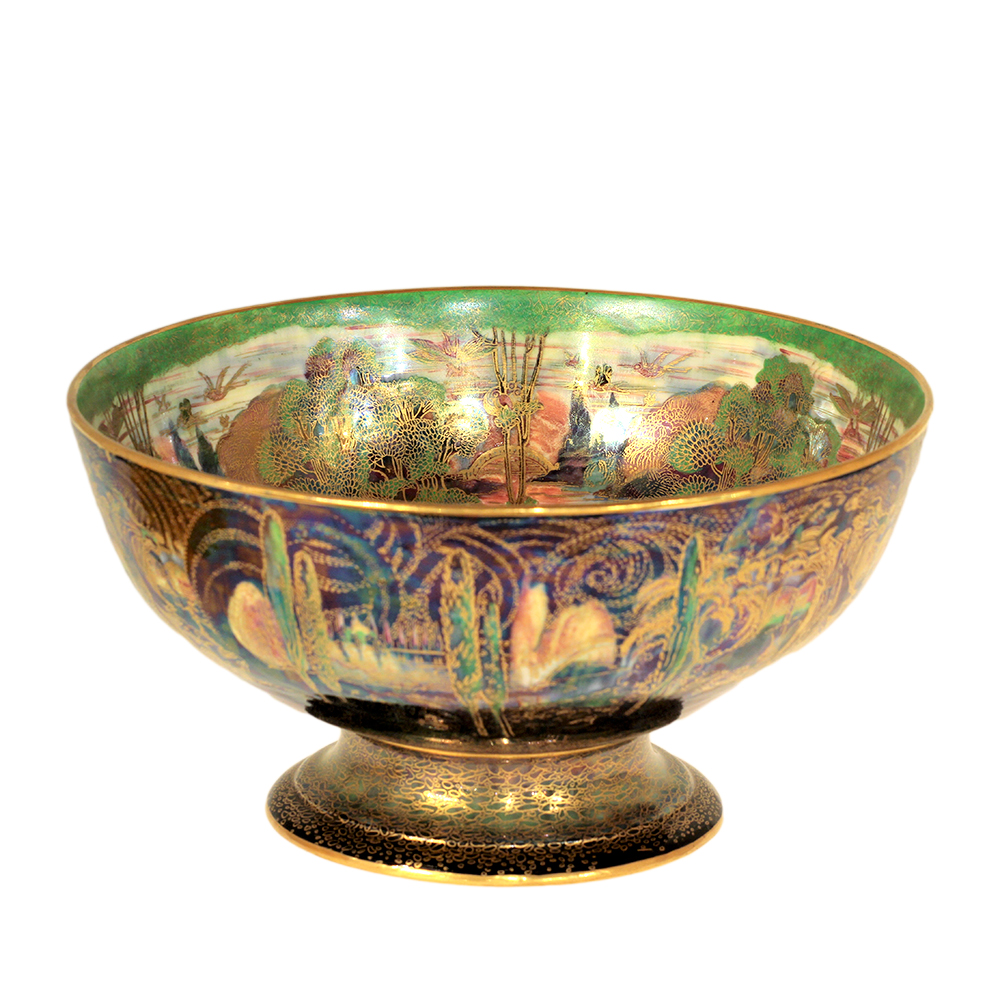
Woodland Elves V with Woodland Bridge Interior
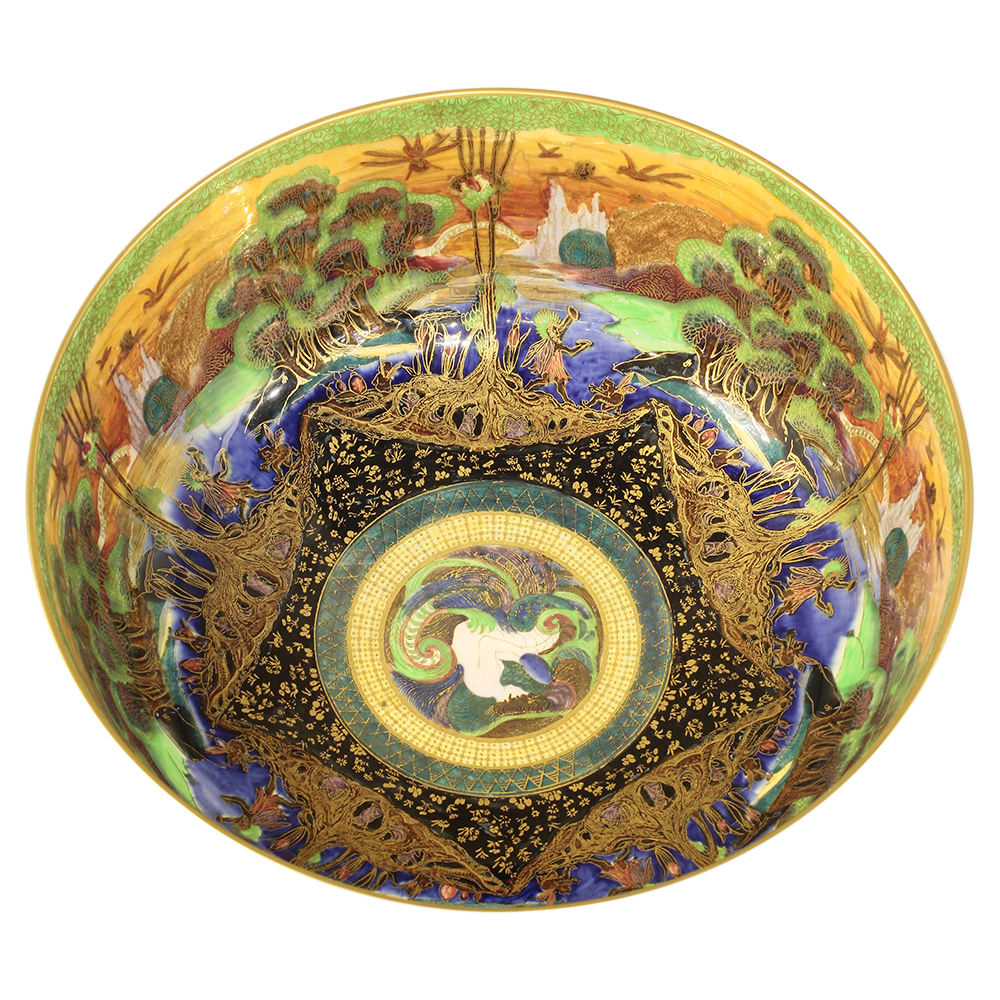
Woodland Bridge Interior
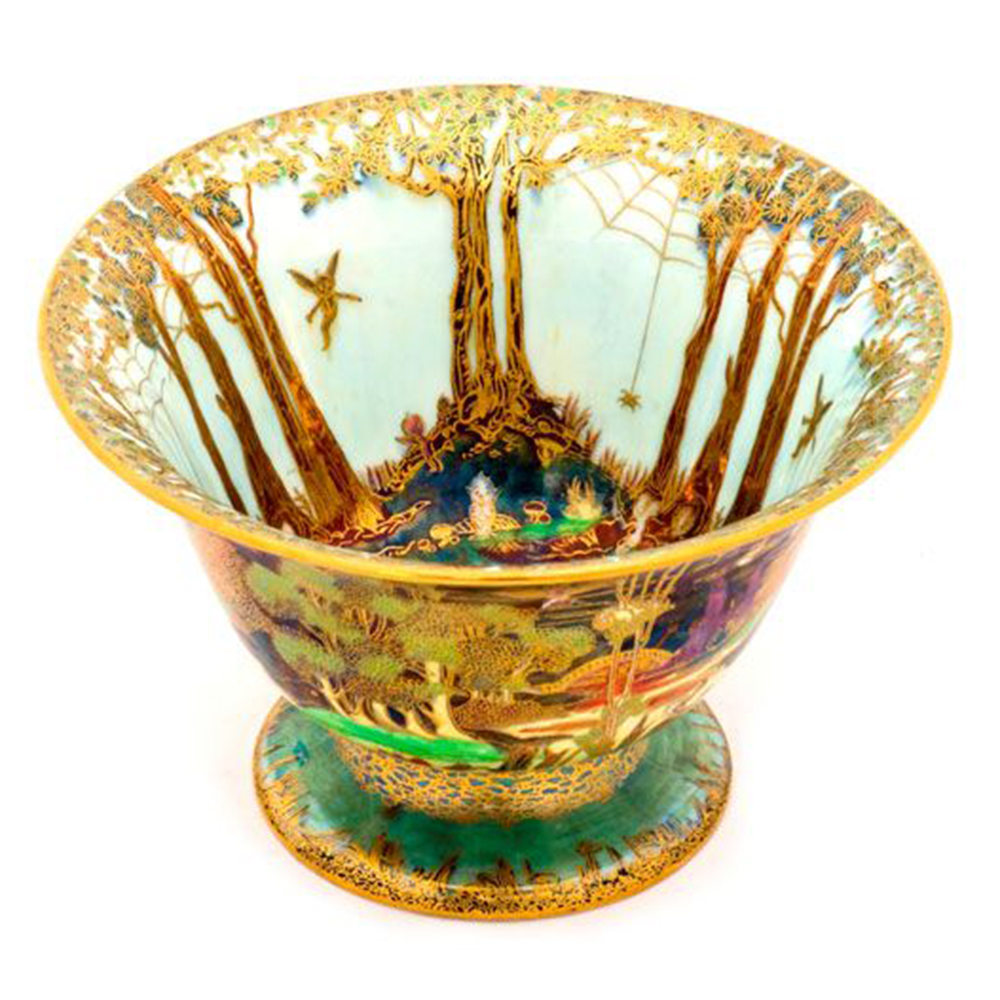
Woodland Elves with Spider & Web Interior
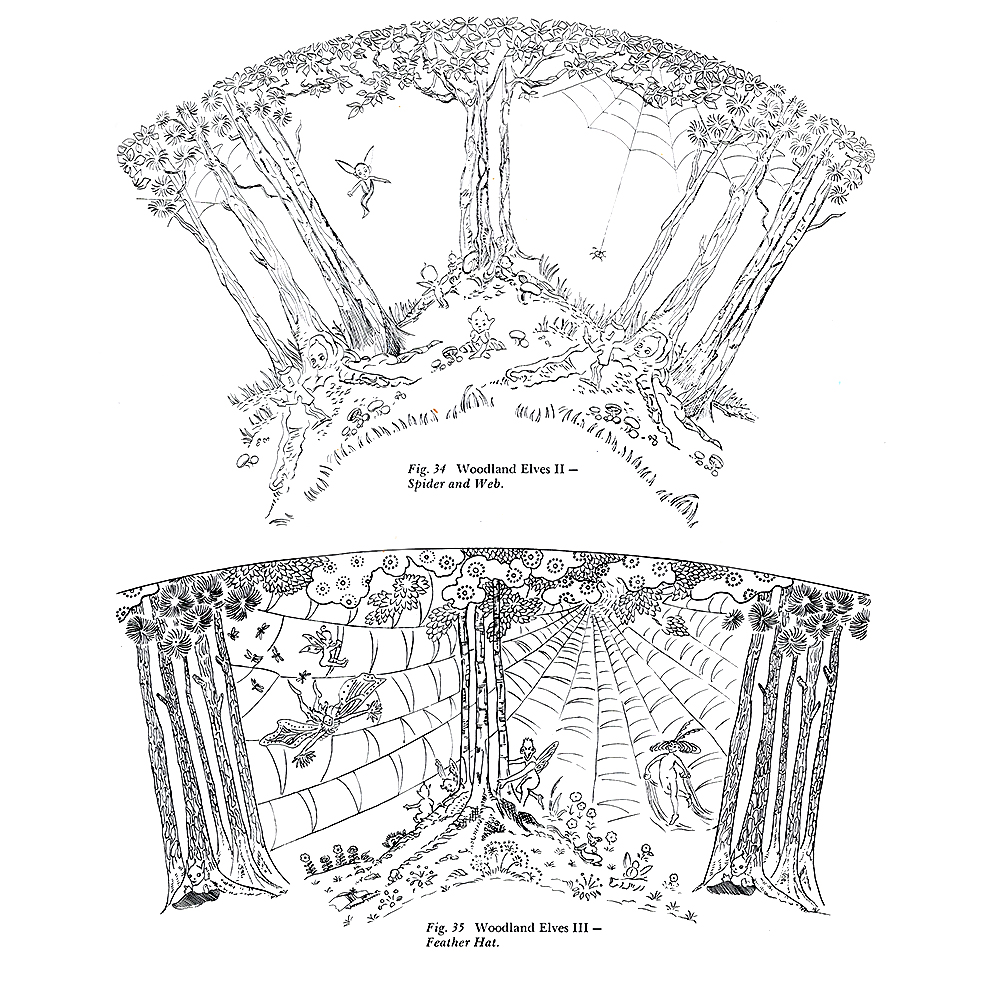
Spider & Web Illustration
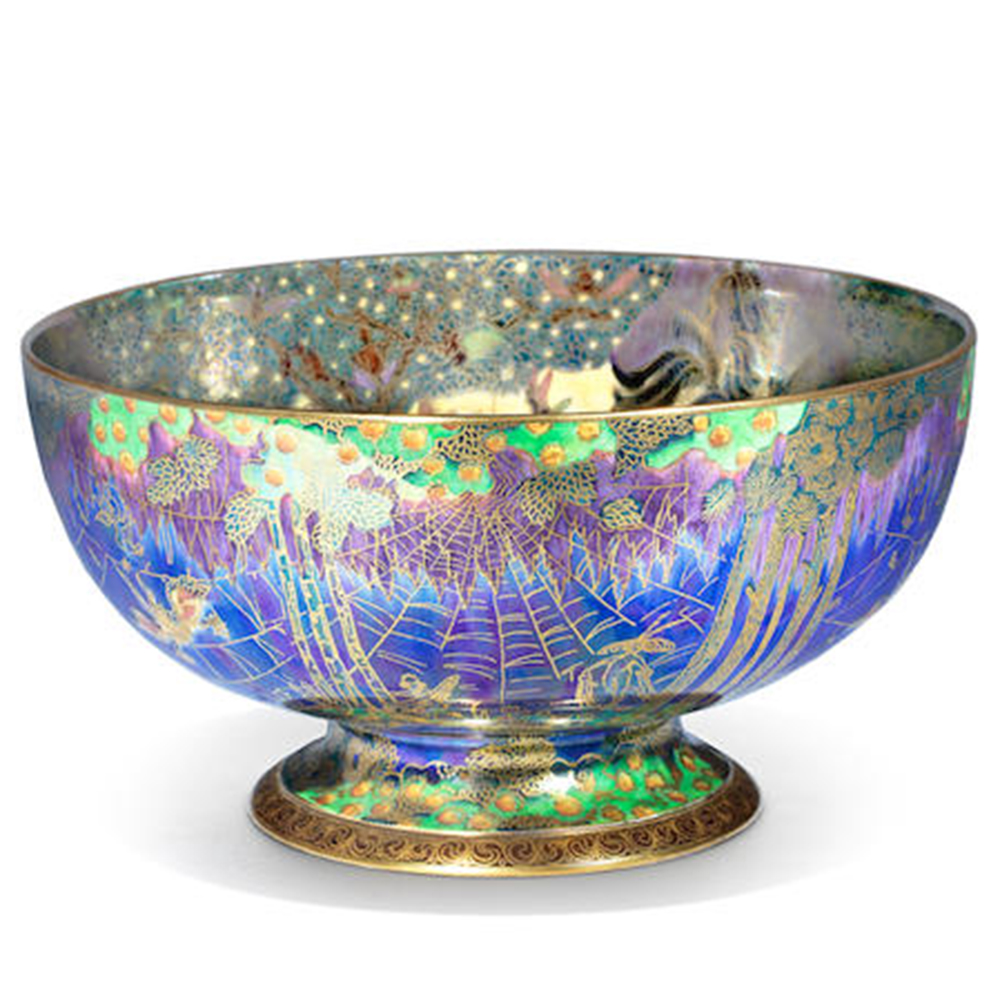
Woodland Elves III Feather Hat Exterior
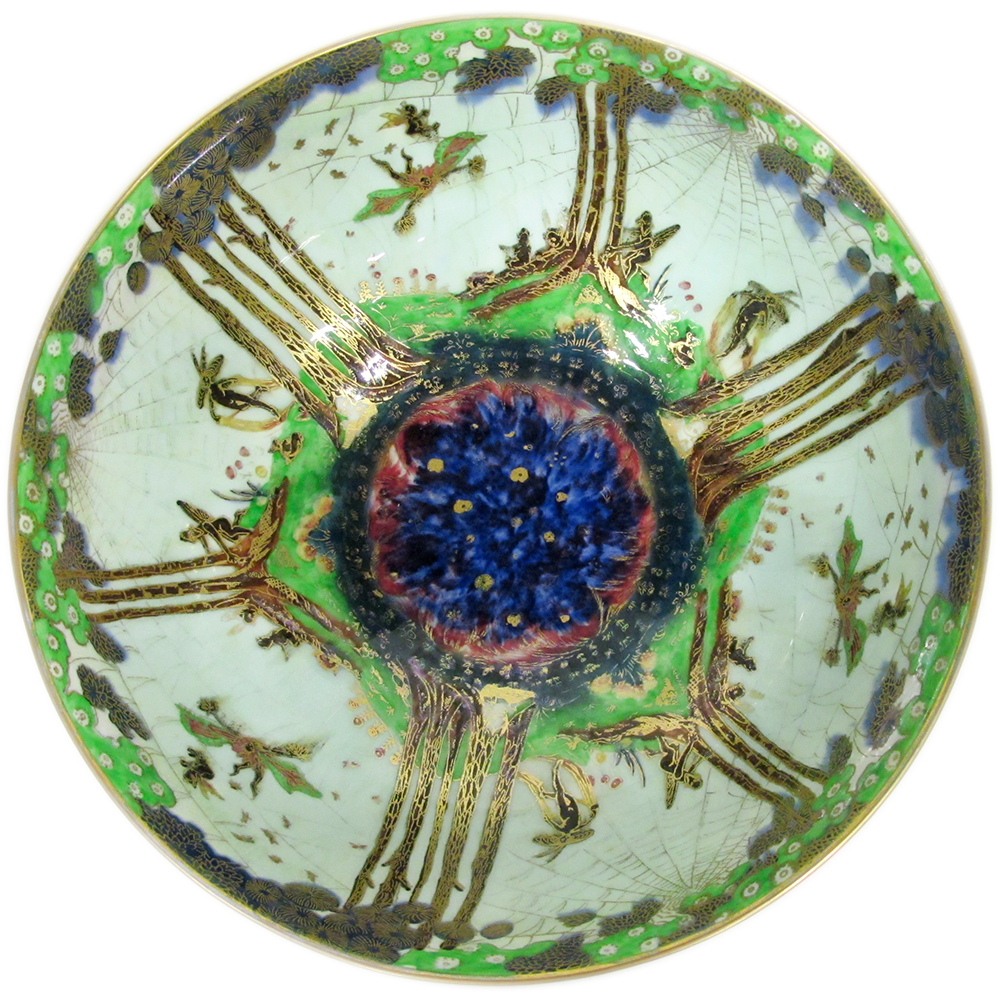
Feather Hat Interior
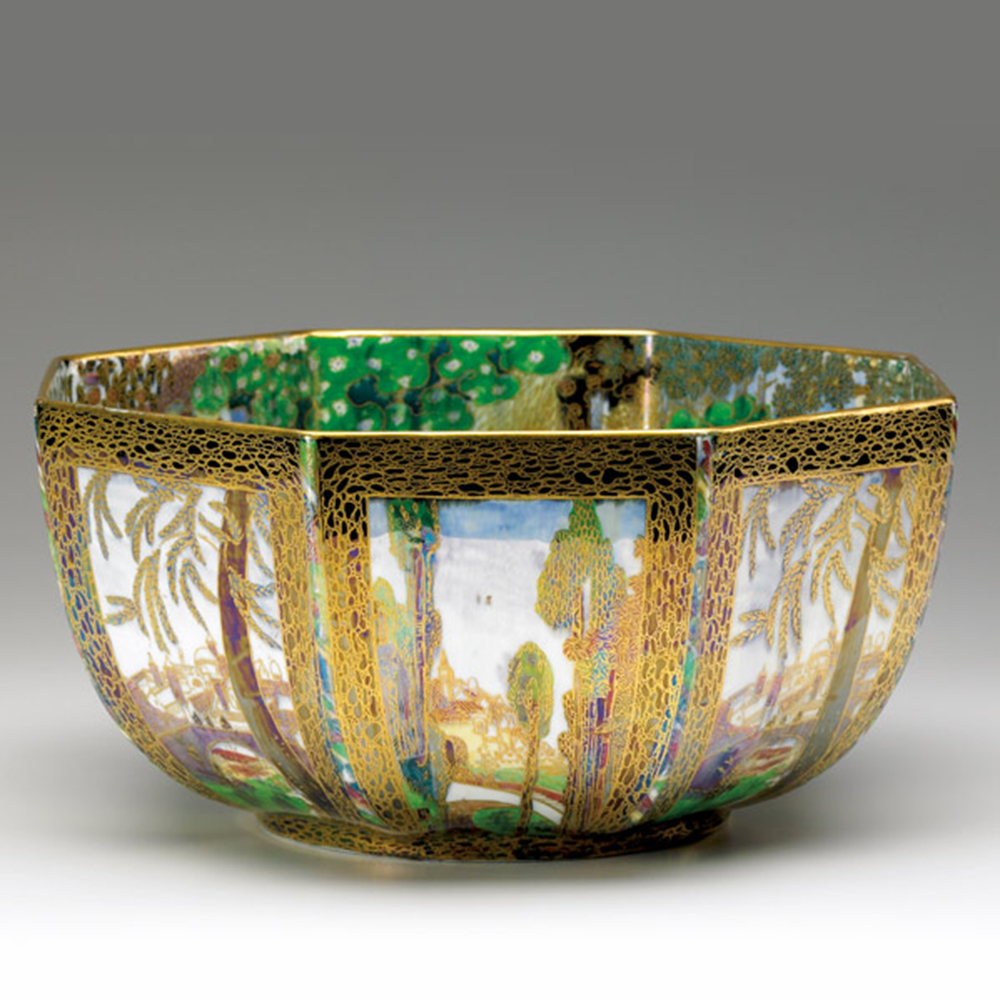
Dana Castle on Road with Boxing Match Interior
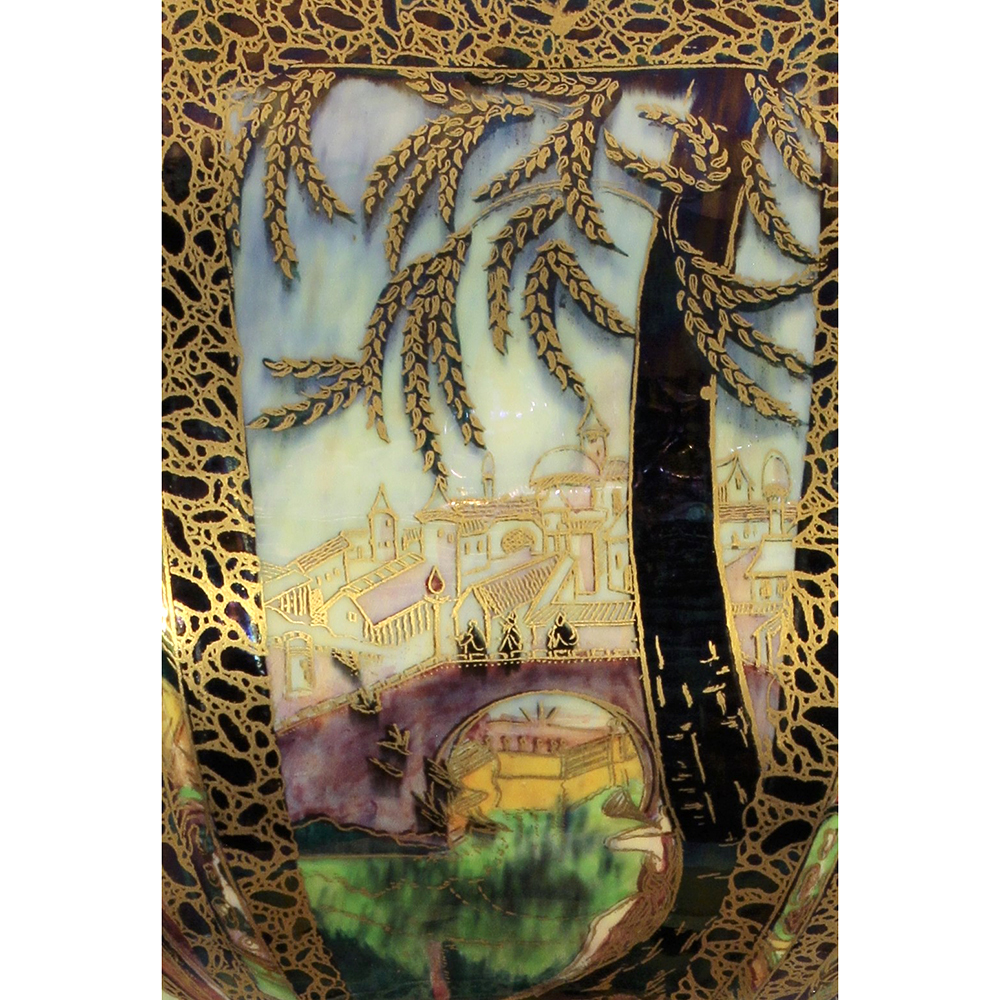
Dana Castle on Road Detail
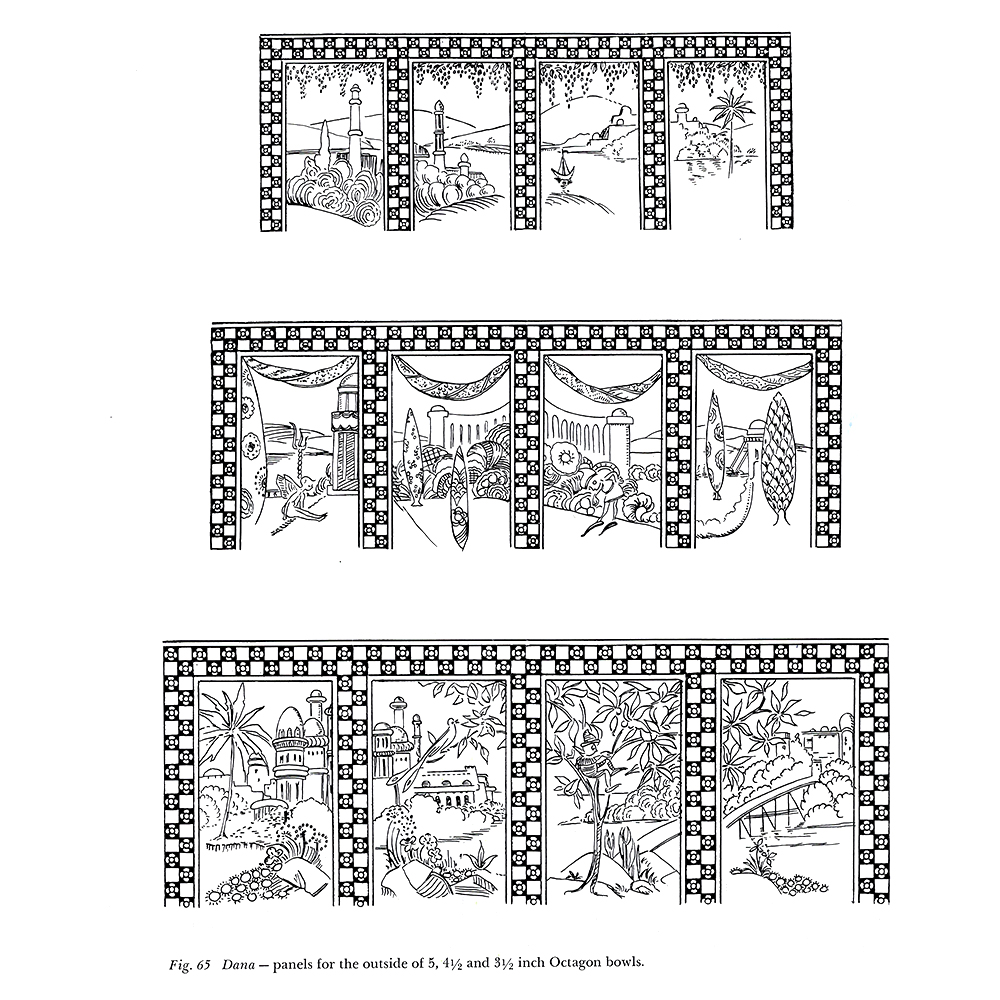
Dana Castle on Road Illustration
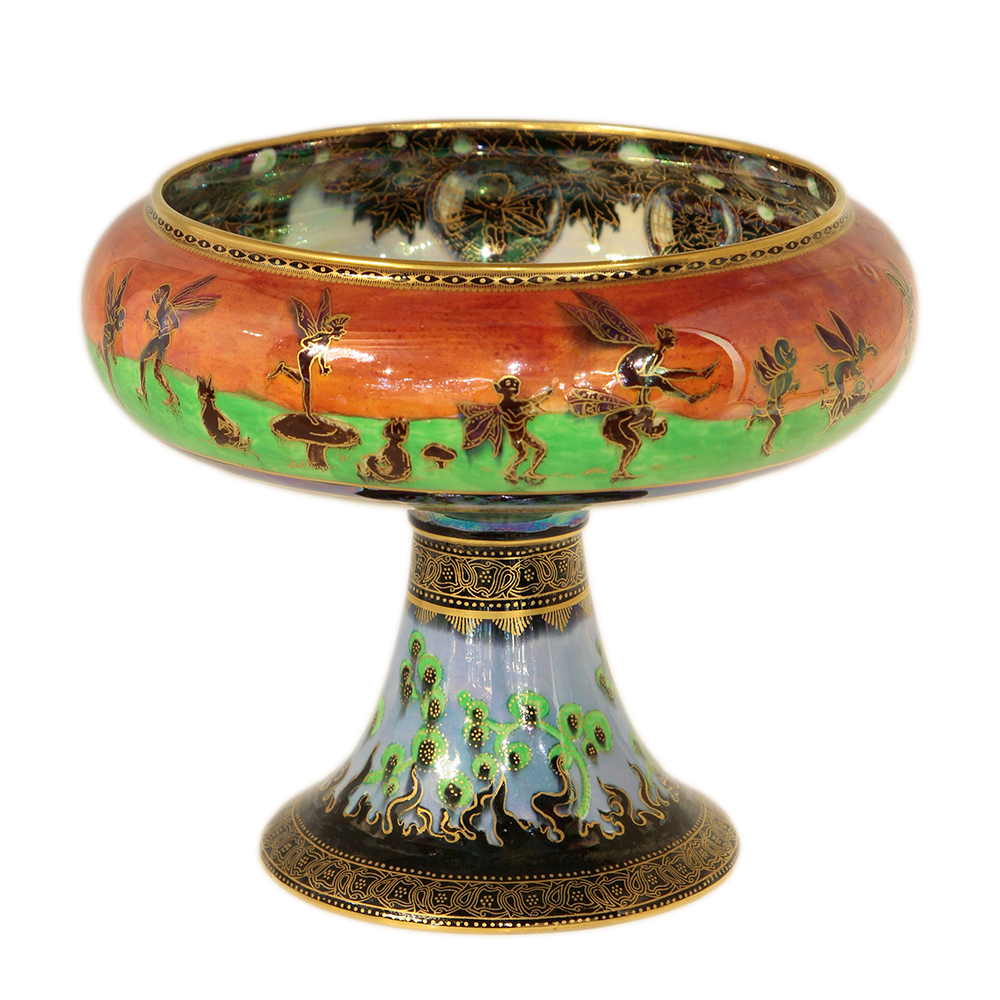
Leapfrogging Elves Persian Cup
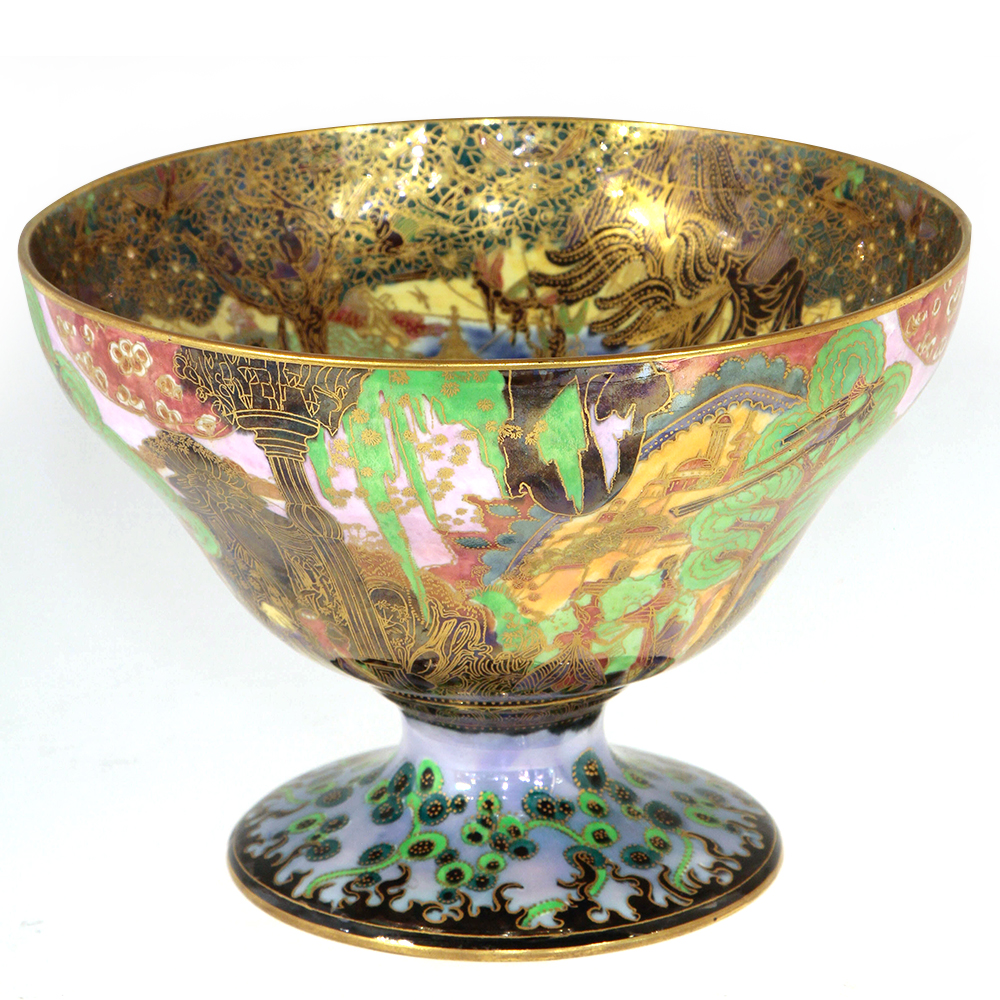
Garden of Paradise Melba Bowl
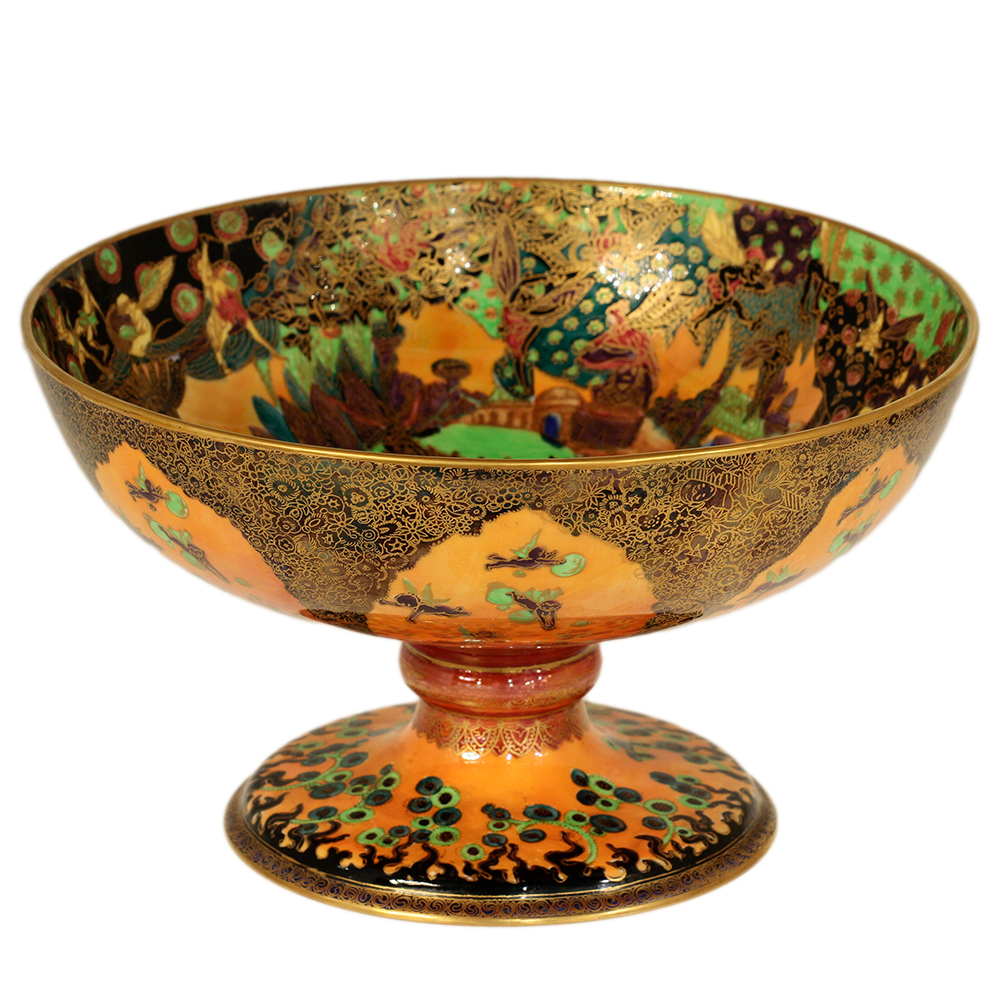
Fairy Gondola Chalice Bowl
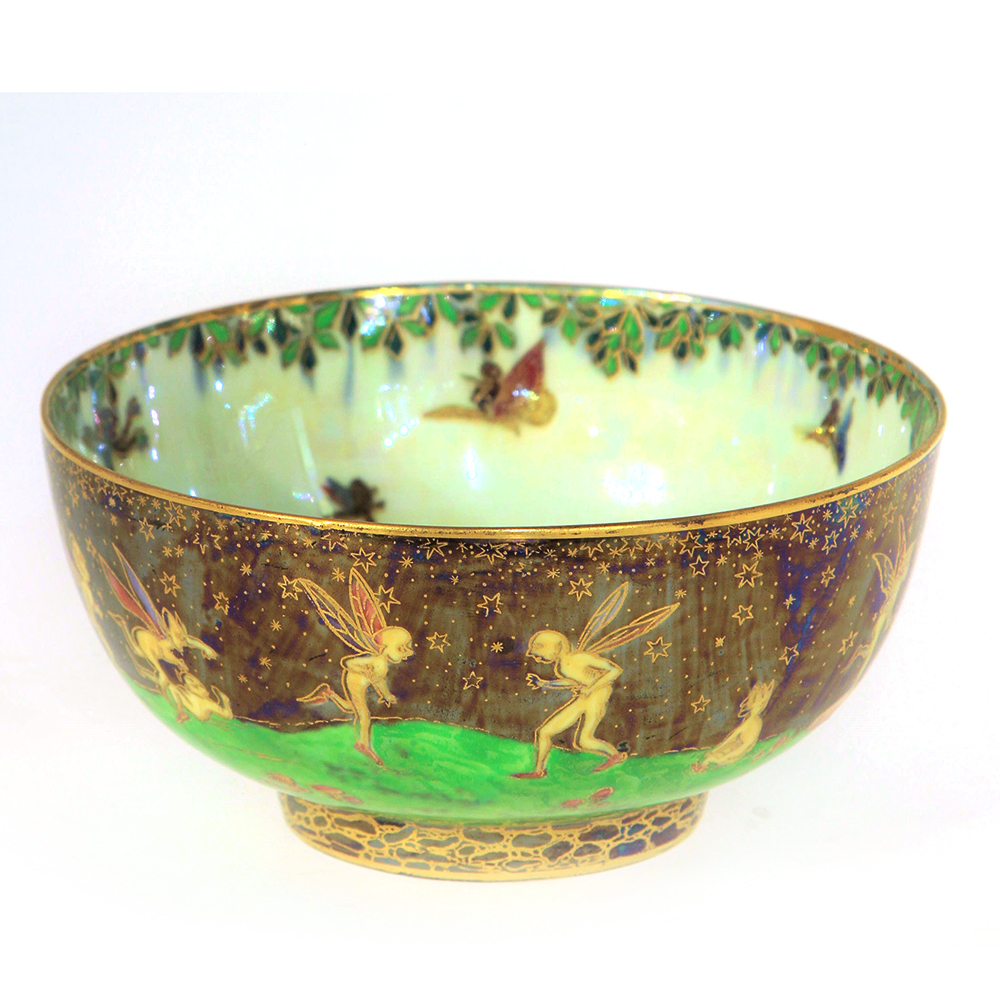
Leapfrogging Elves Bowl
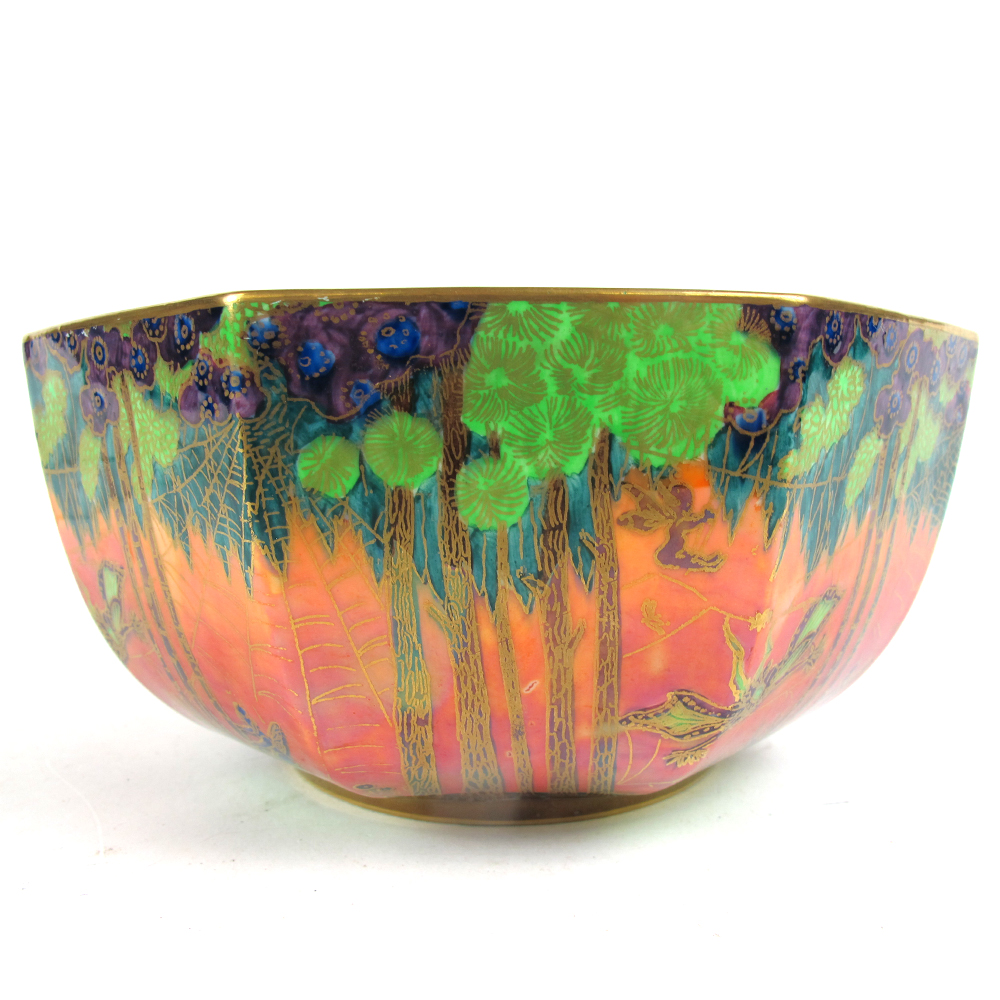
Jumping Faun Flame Octagon Bowl
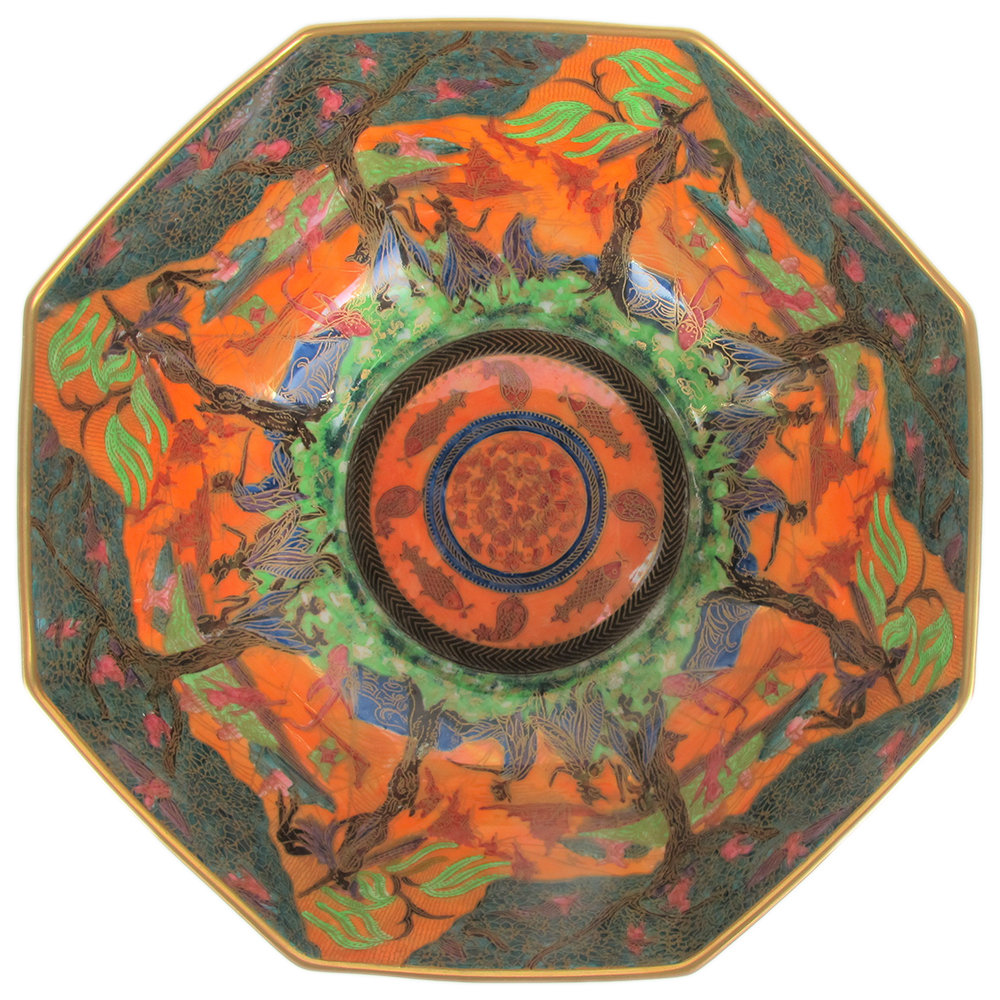
Jumping Faun Flame Interior
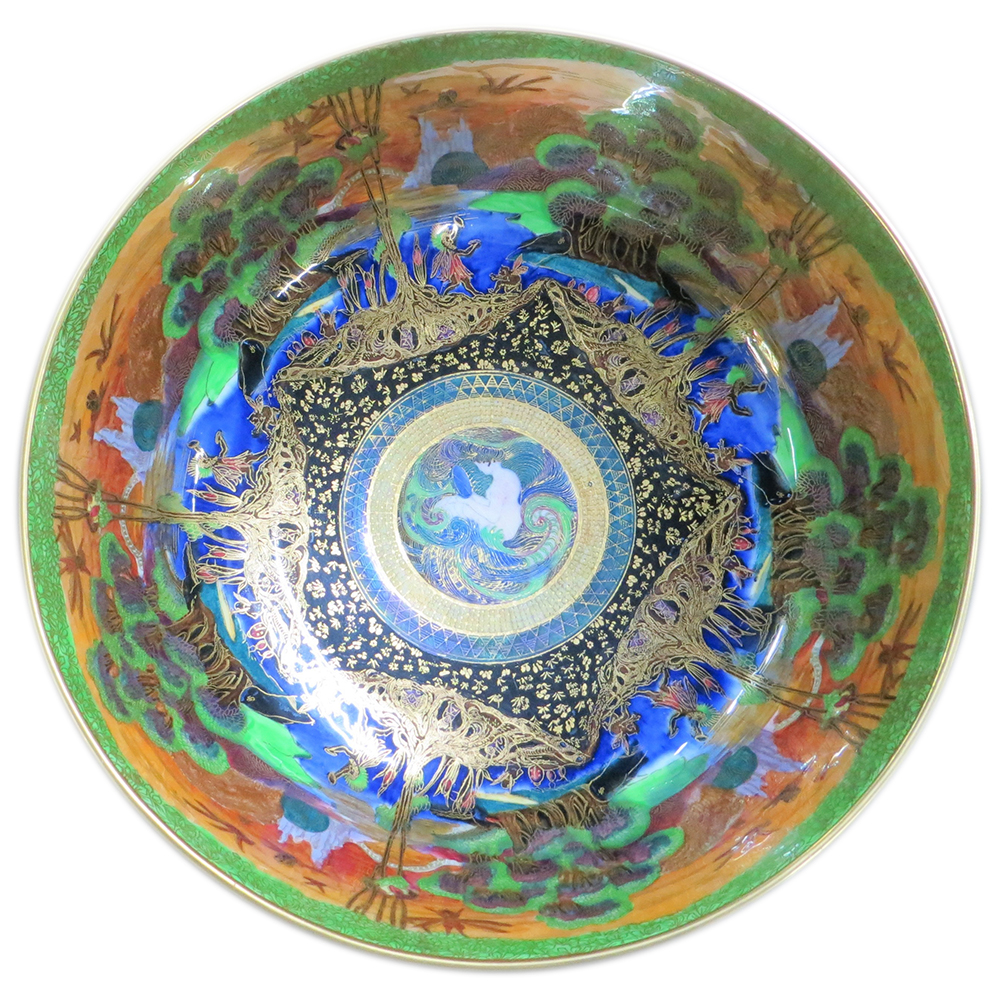
Woodland Bridge Mermaid Center
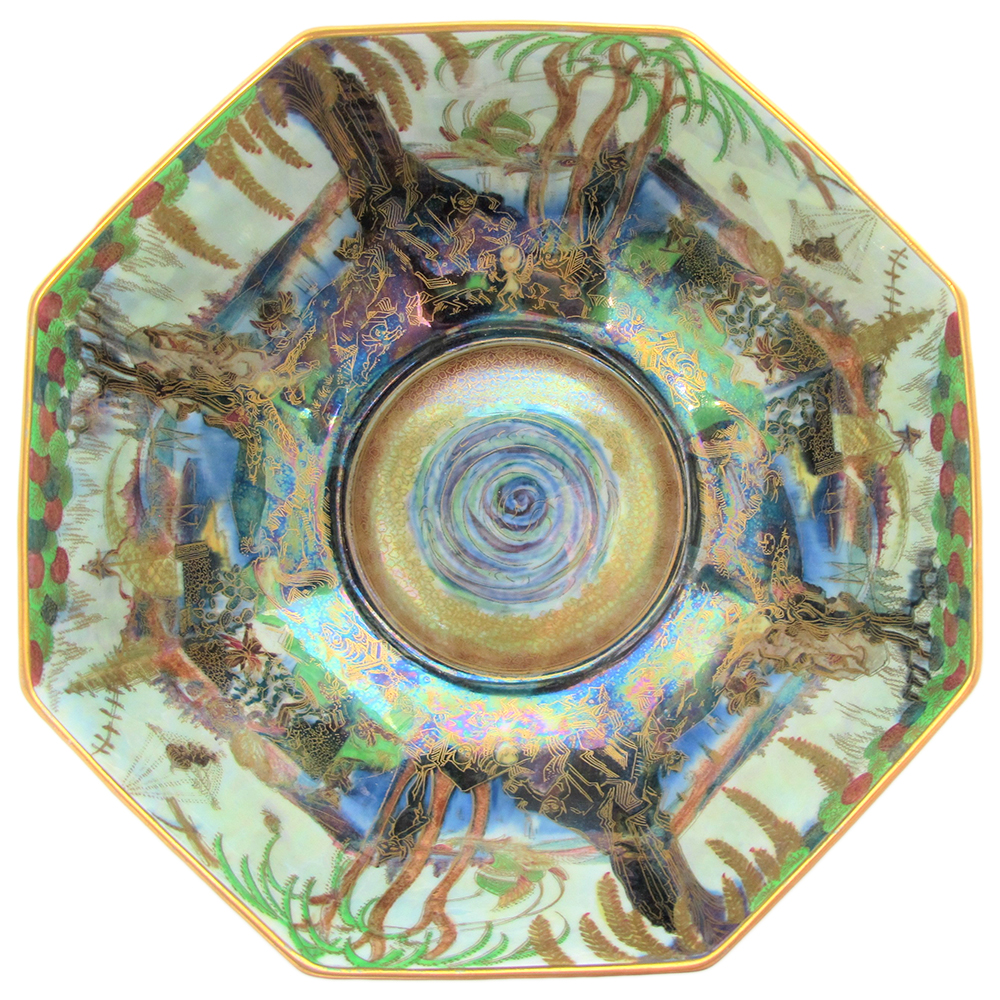
Fairy in a Cage Interior
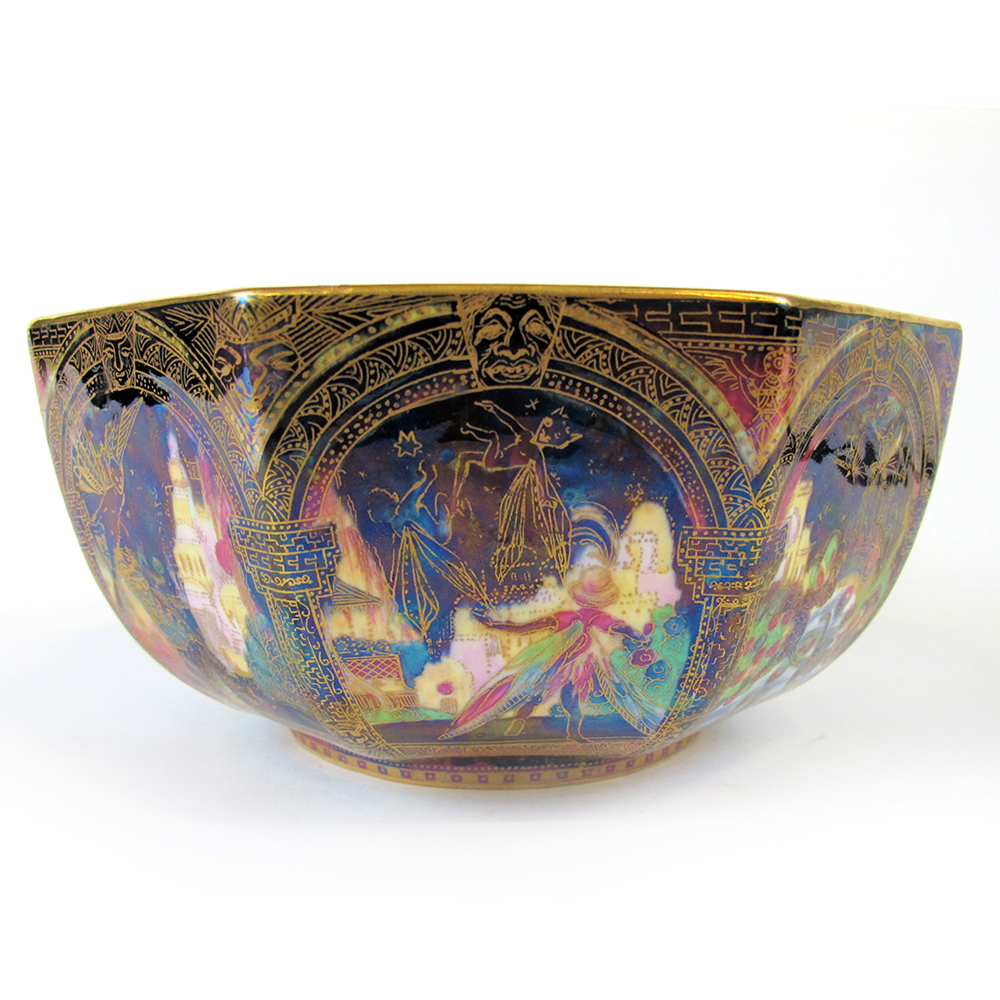
Gargoyles Exterior Bird in a Hoop Interior
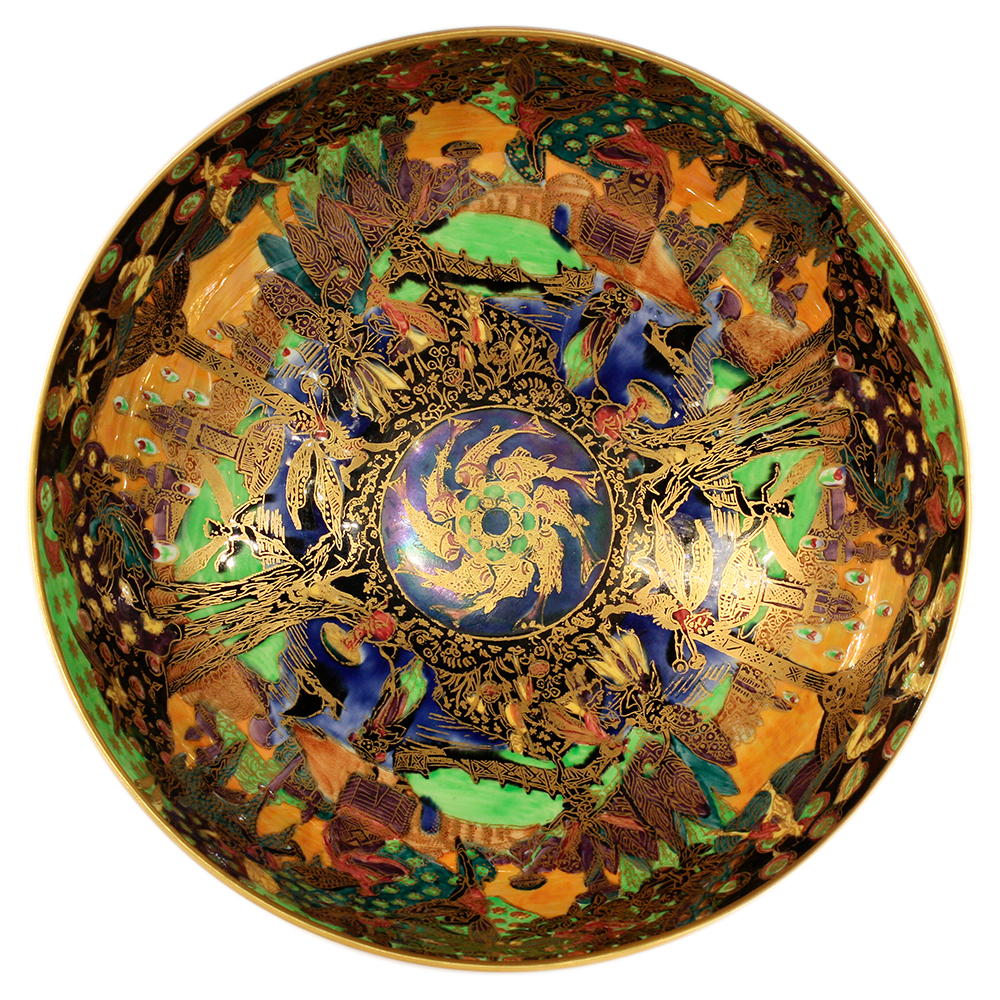
Fairy Gondola Flame Interior
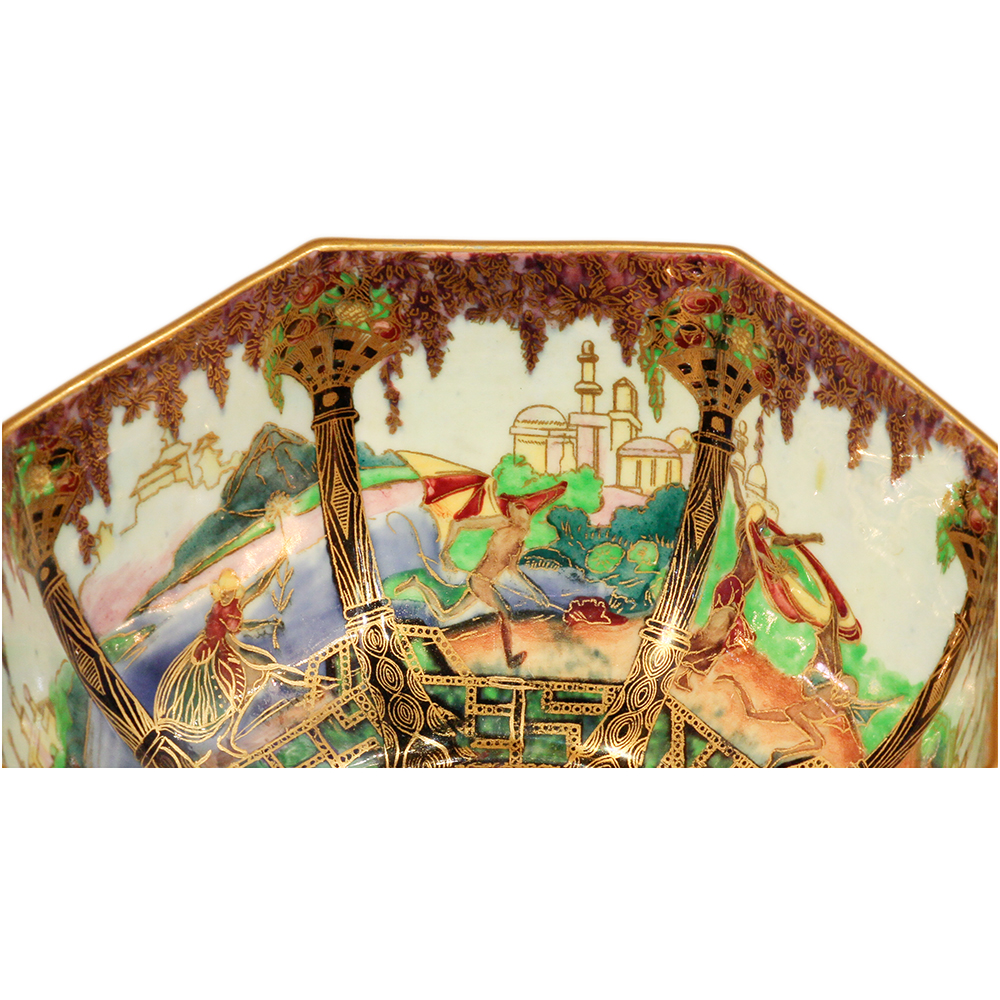
Running Figures Detail
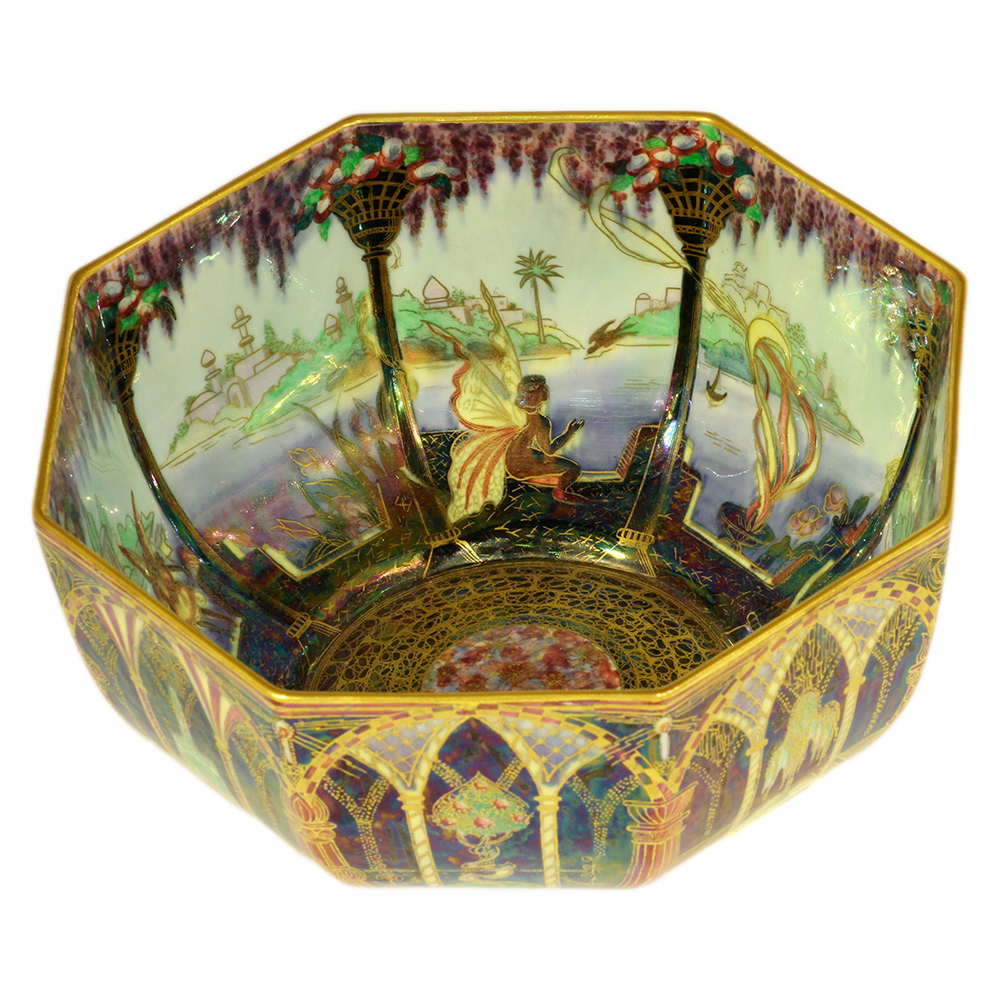
Moorish with Smoke & Ribbons Interior
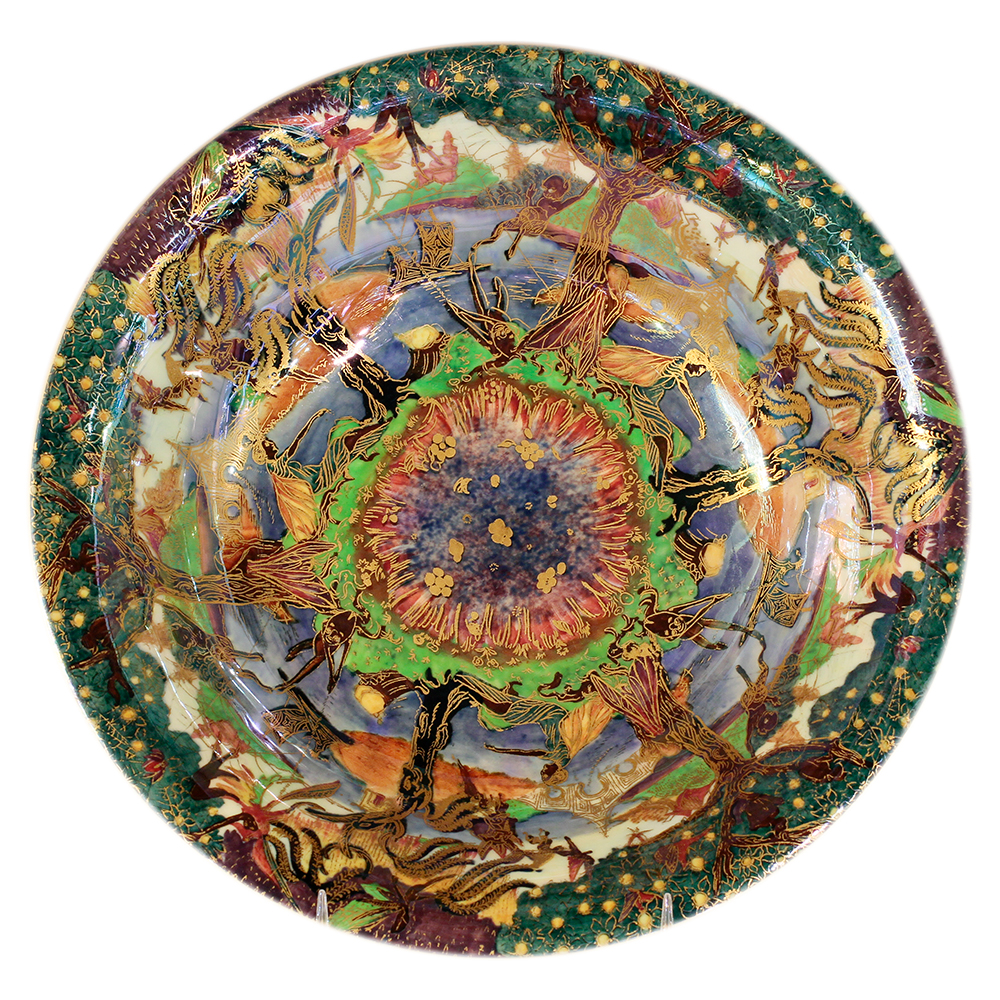
Jumping Faun Interior
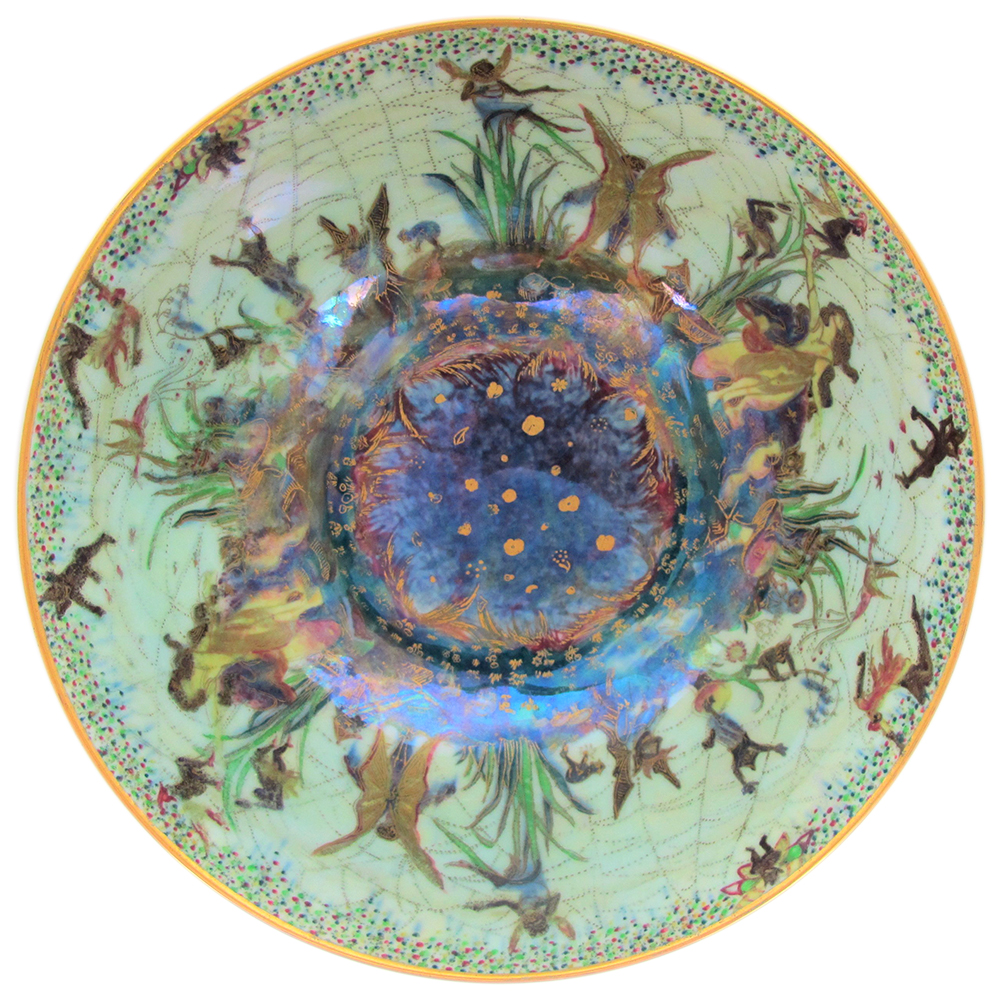
Elves & Bell Branch Interior
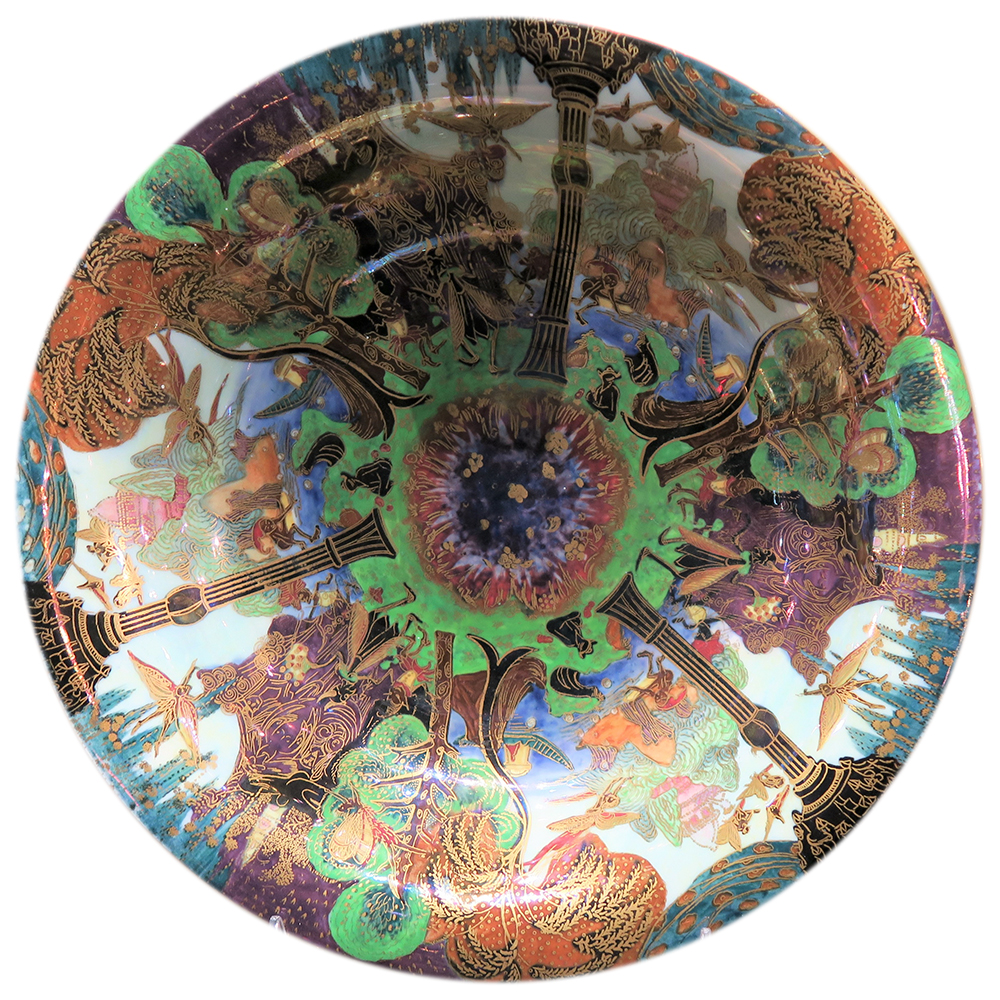
Garden of Paradise Lily Tray
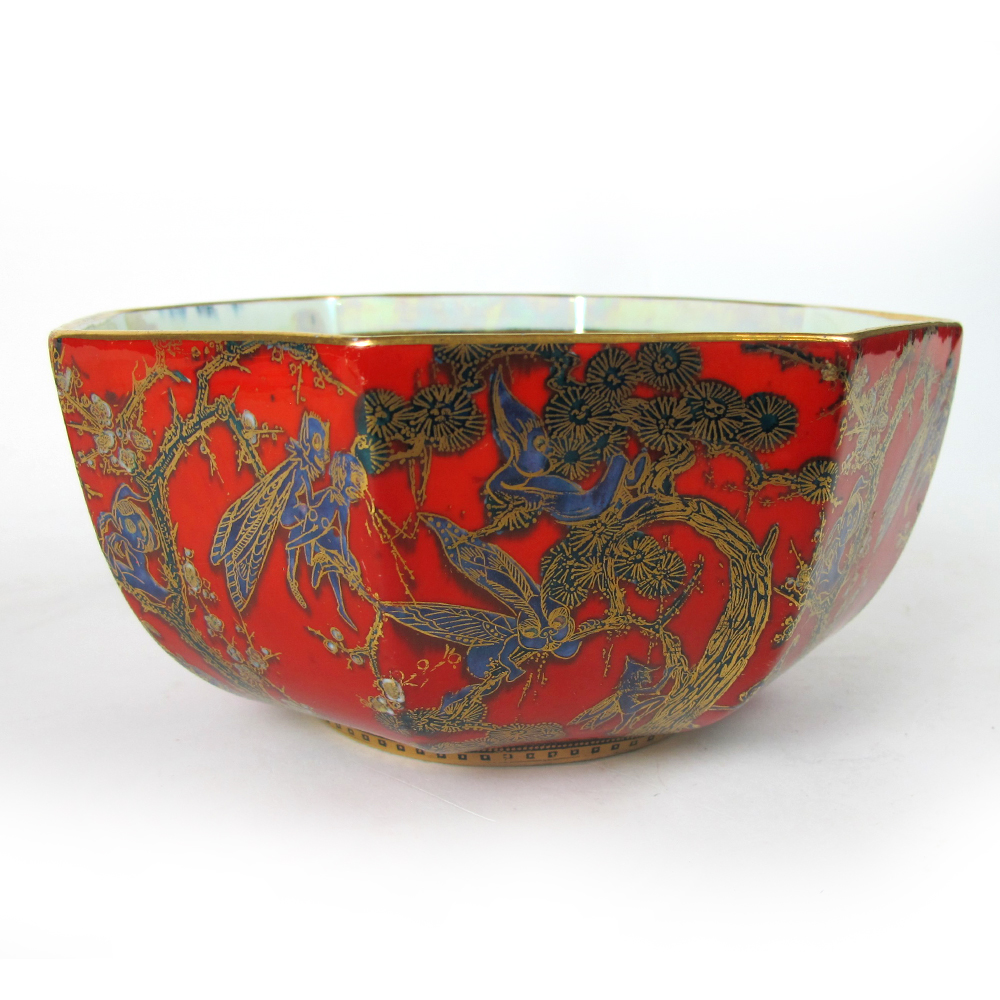
Firbolgs with Thumbelina Interior Ruby
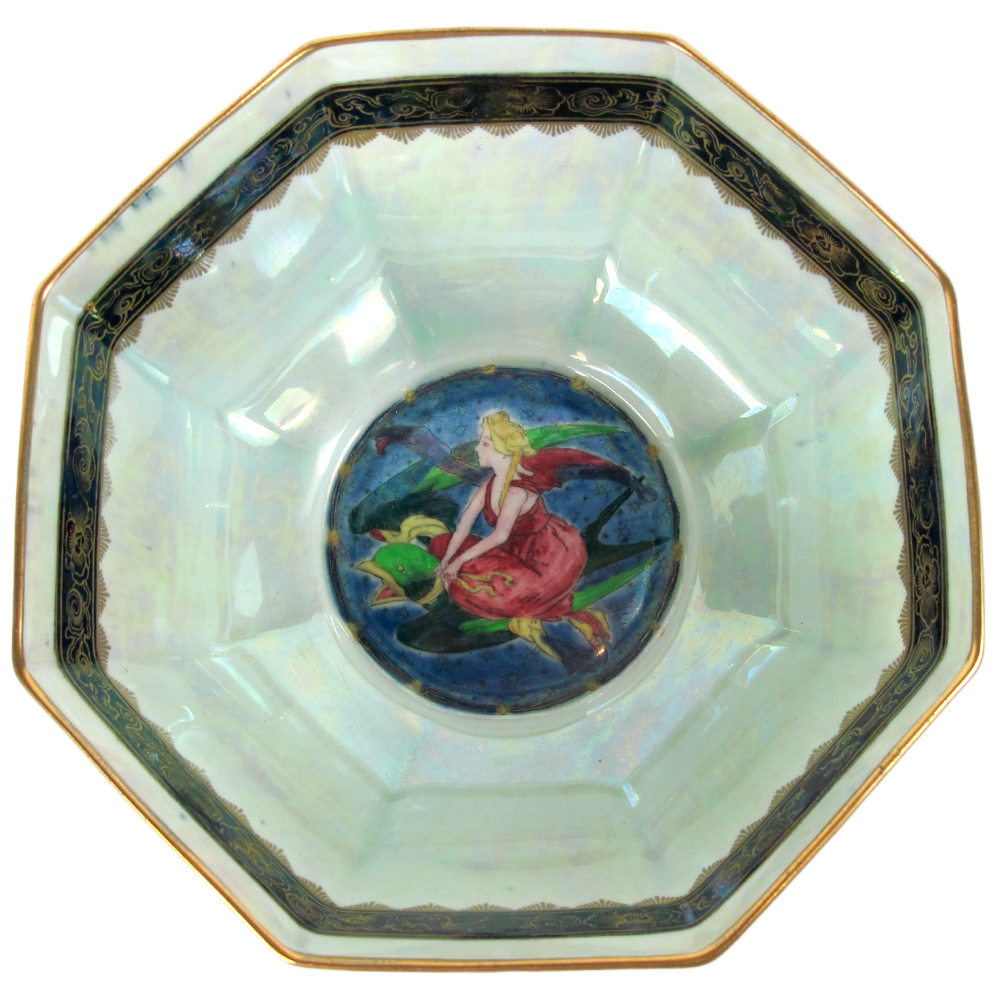
Firbolgs with Thumbelina Interior Ruby
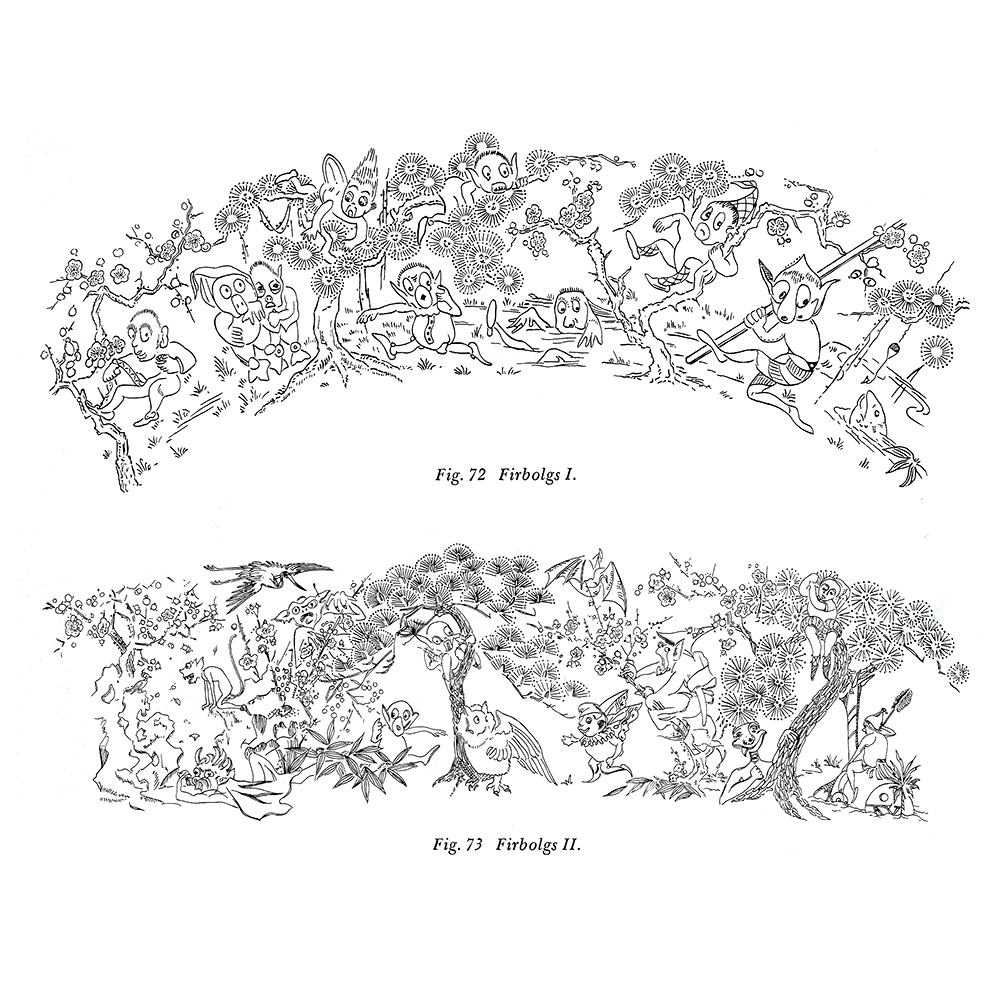
Firbolgs Illustration
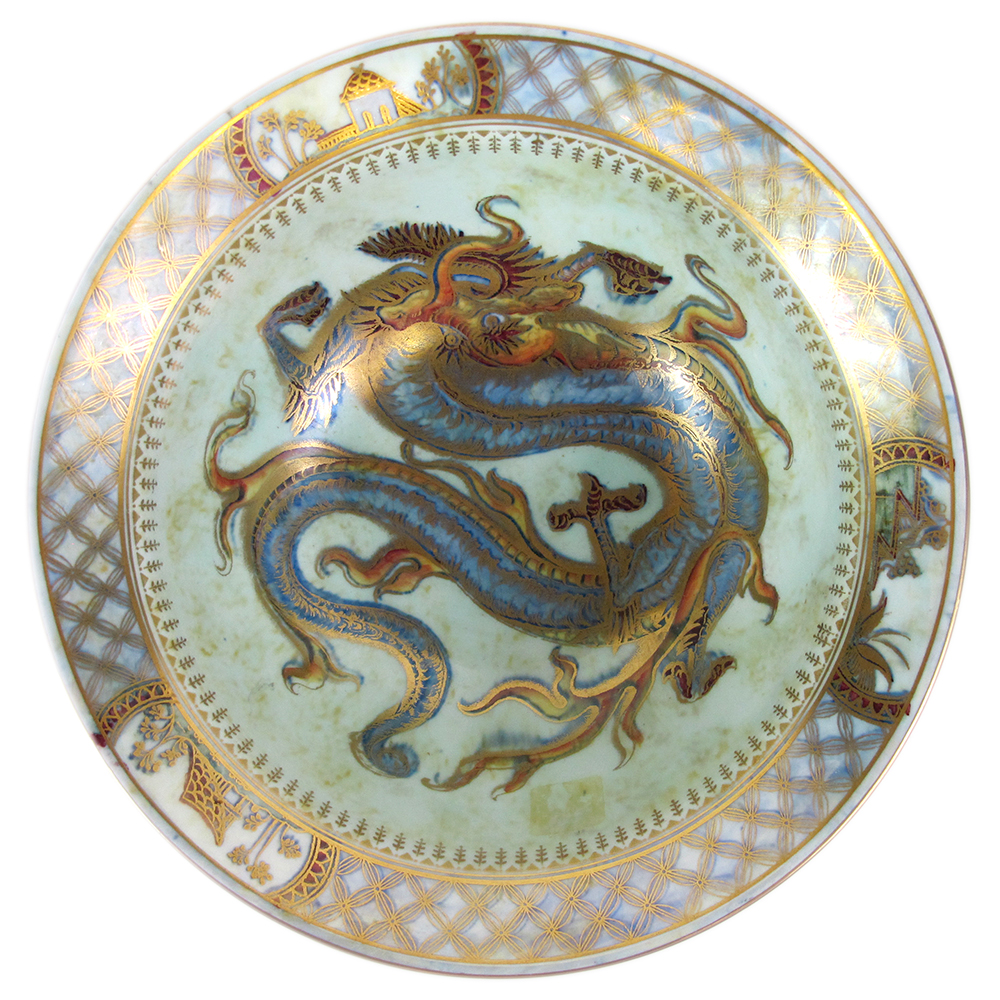
Dragon Interior
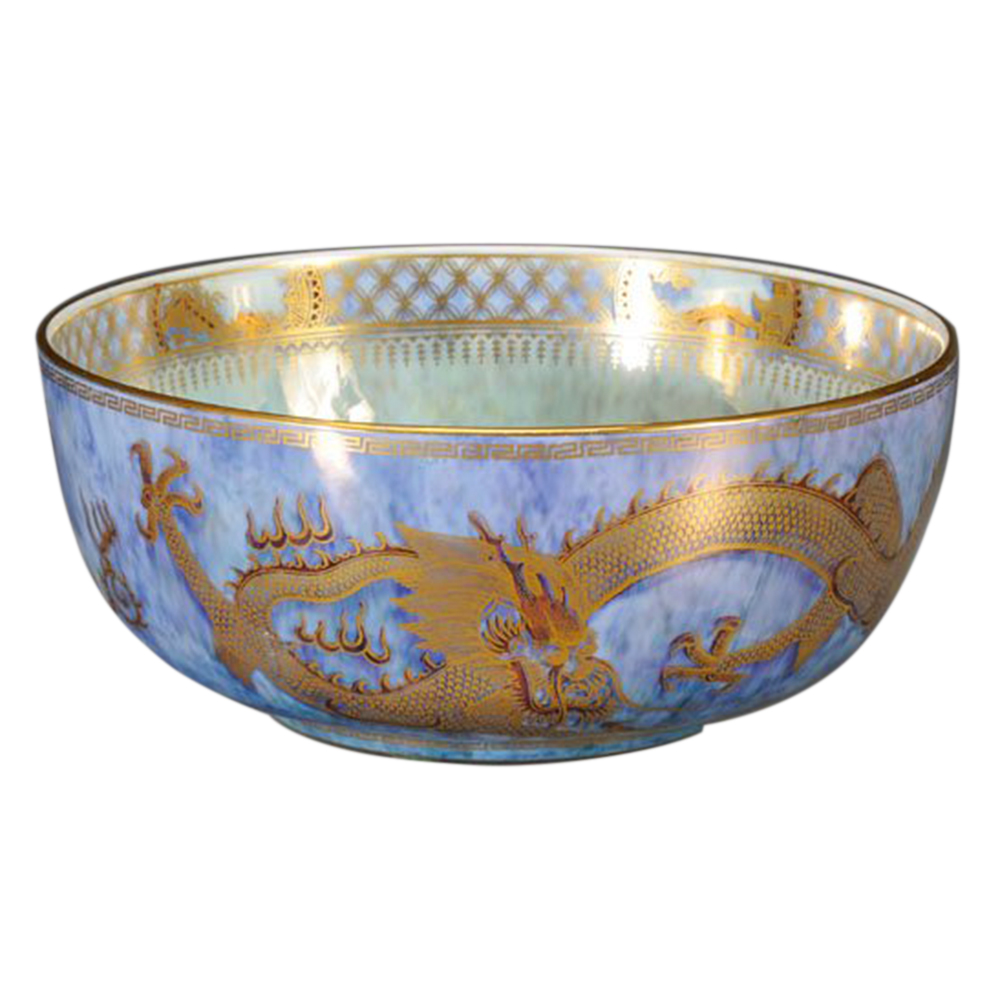
Dragon Exterior
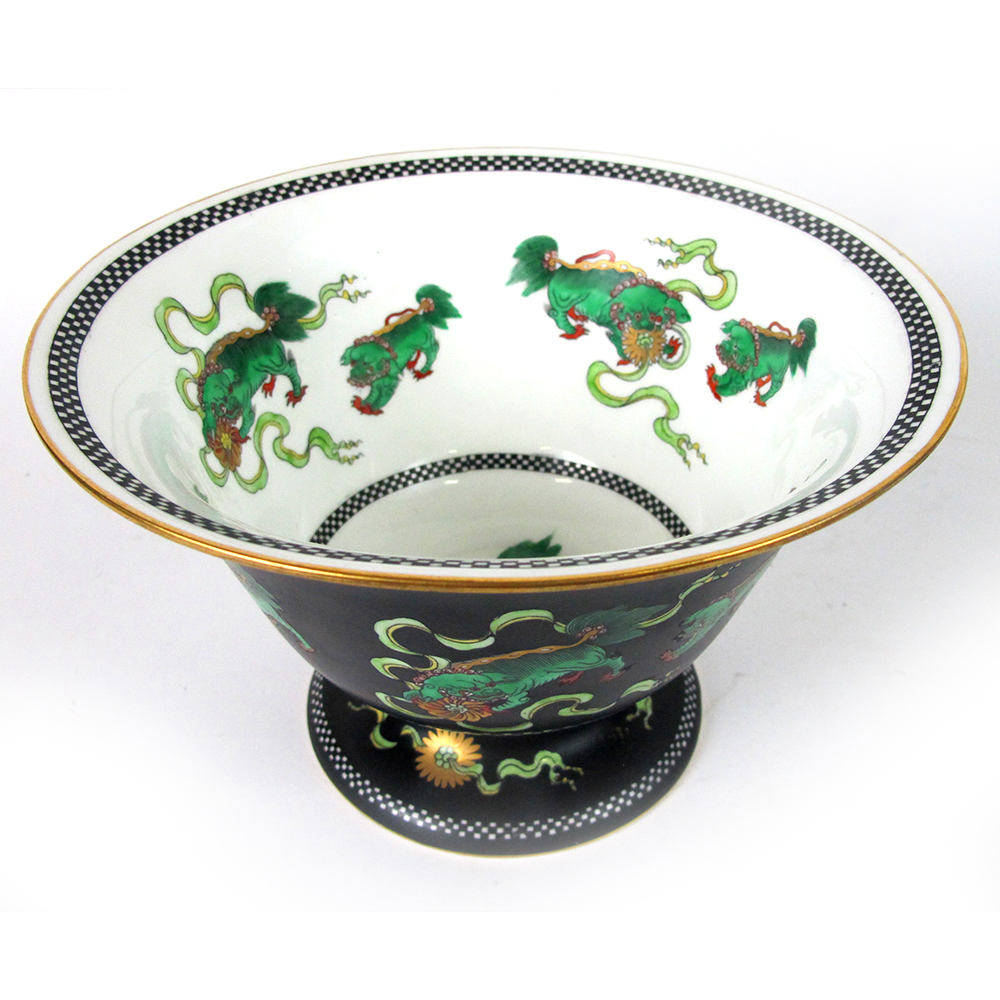
Dragon Interior
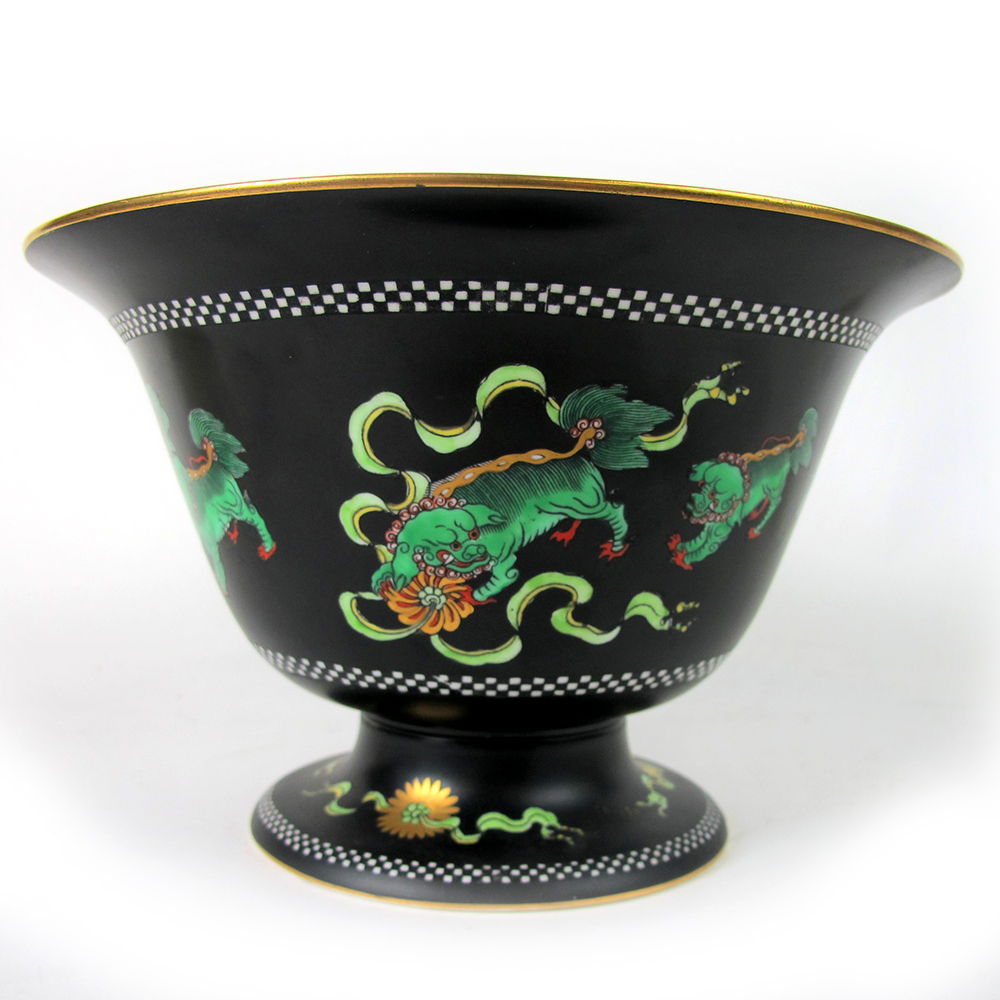
Dragon Exterior
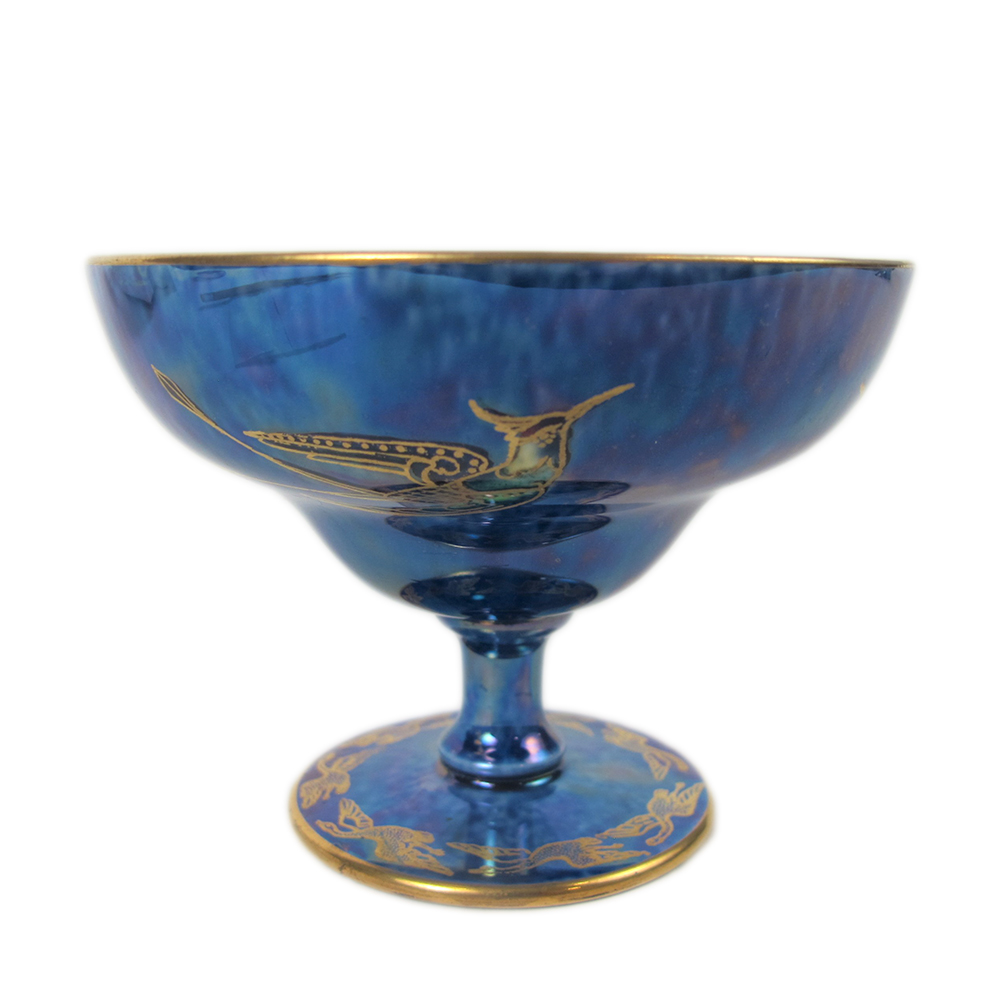
Hummingbird Cup
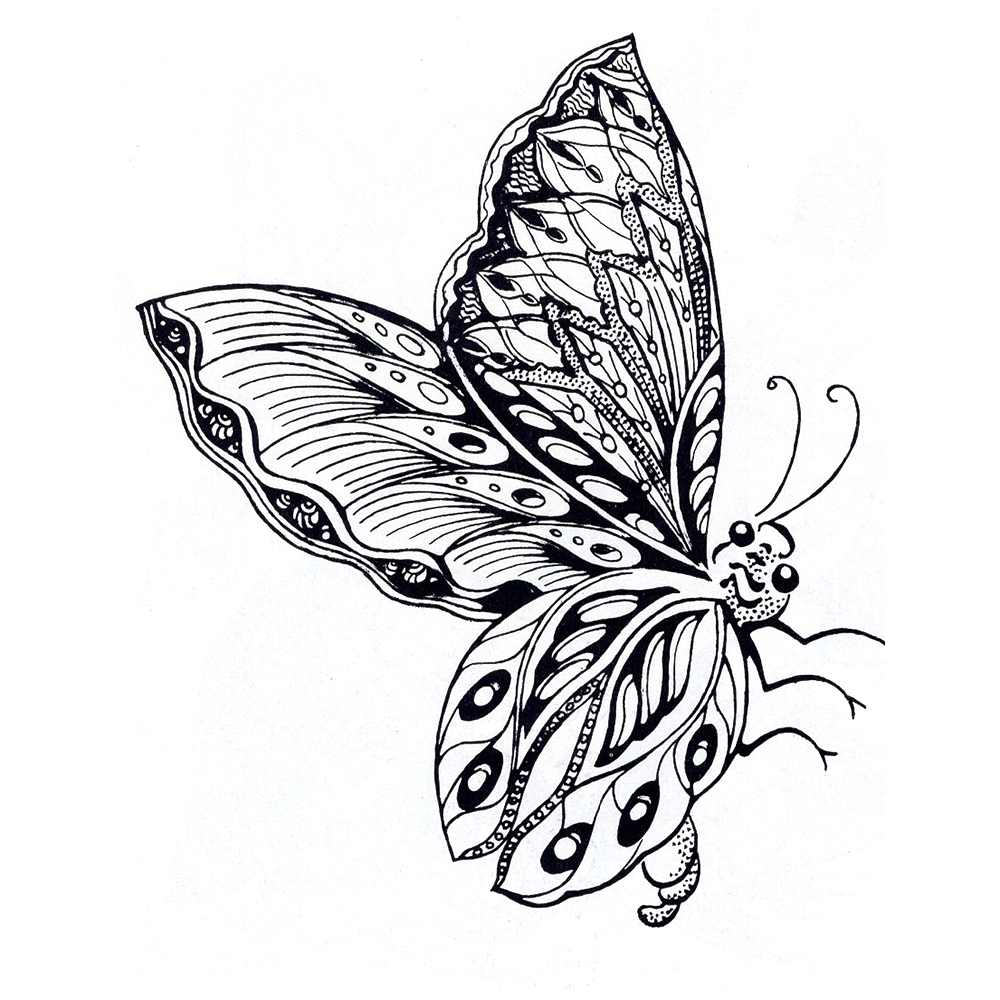
Butterfly Illustration

